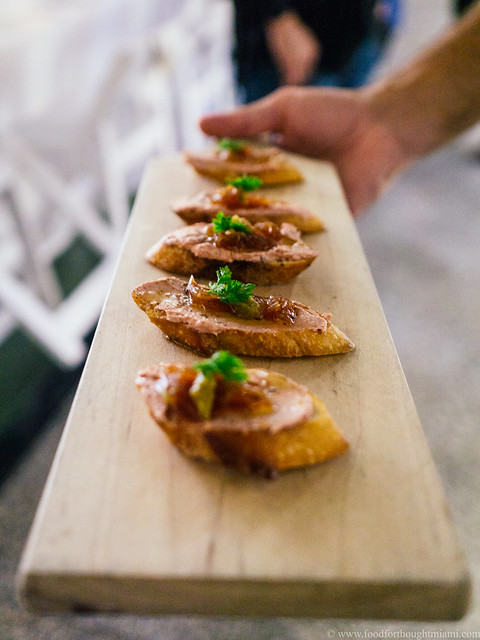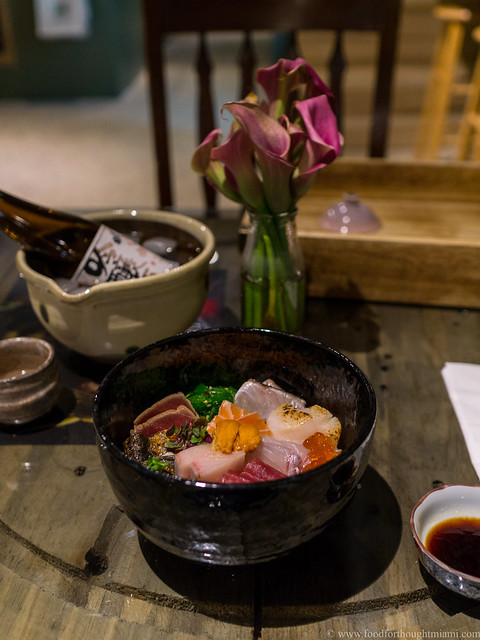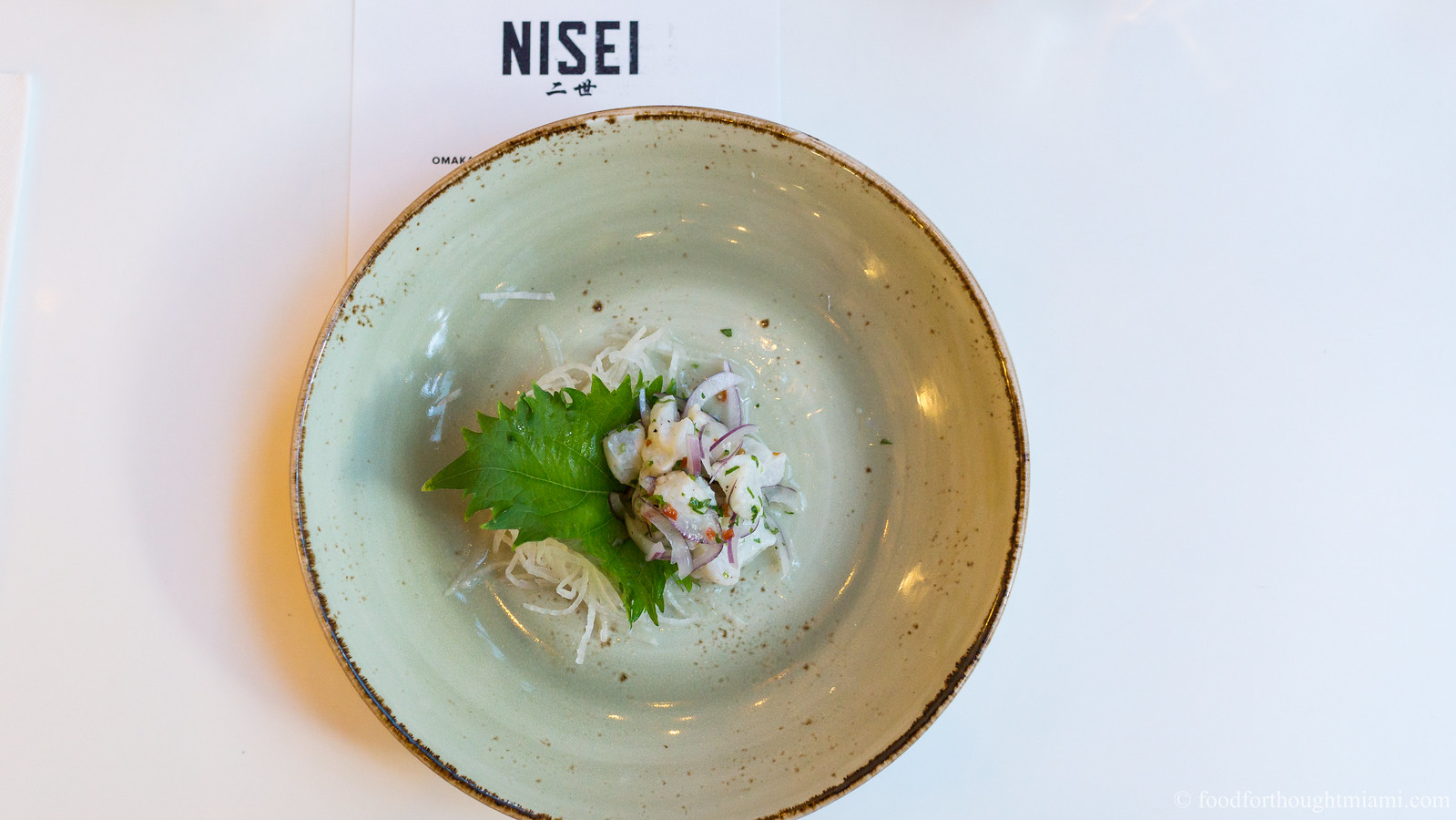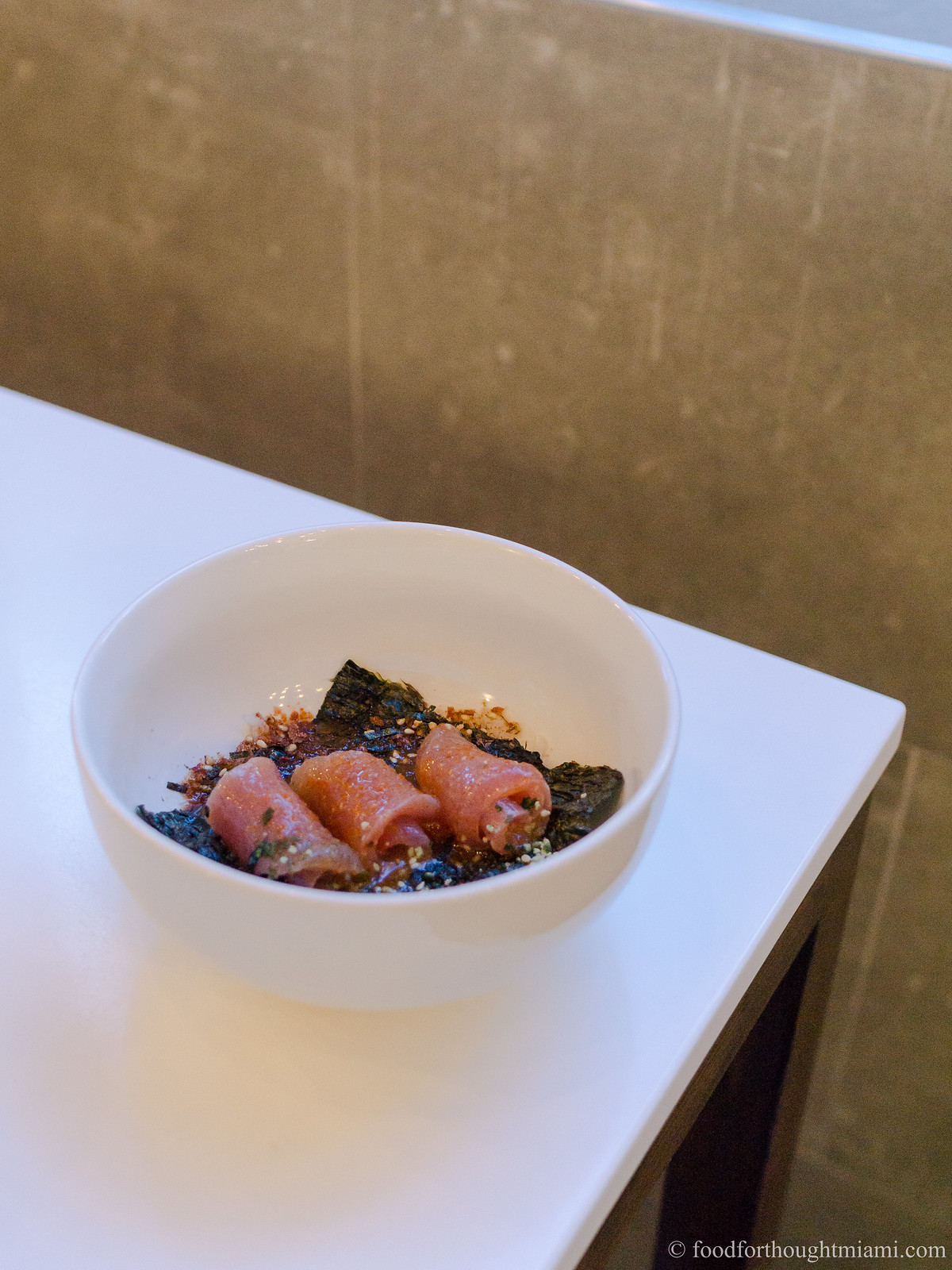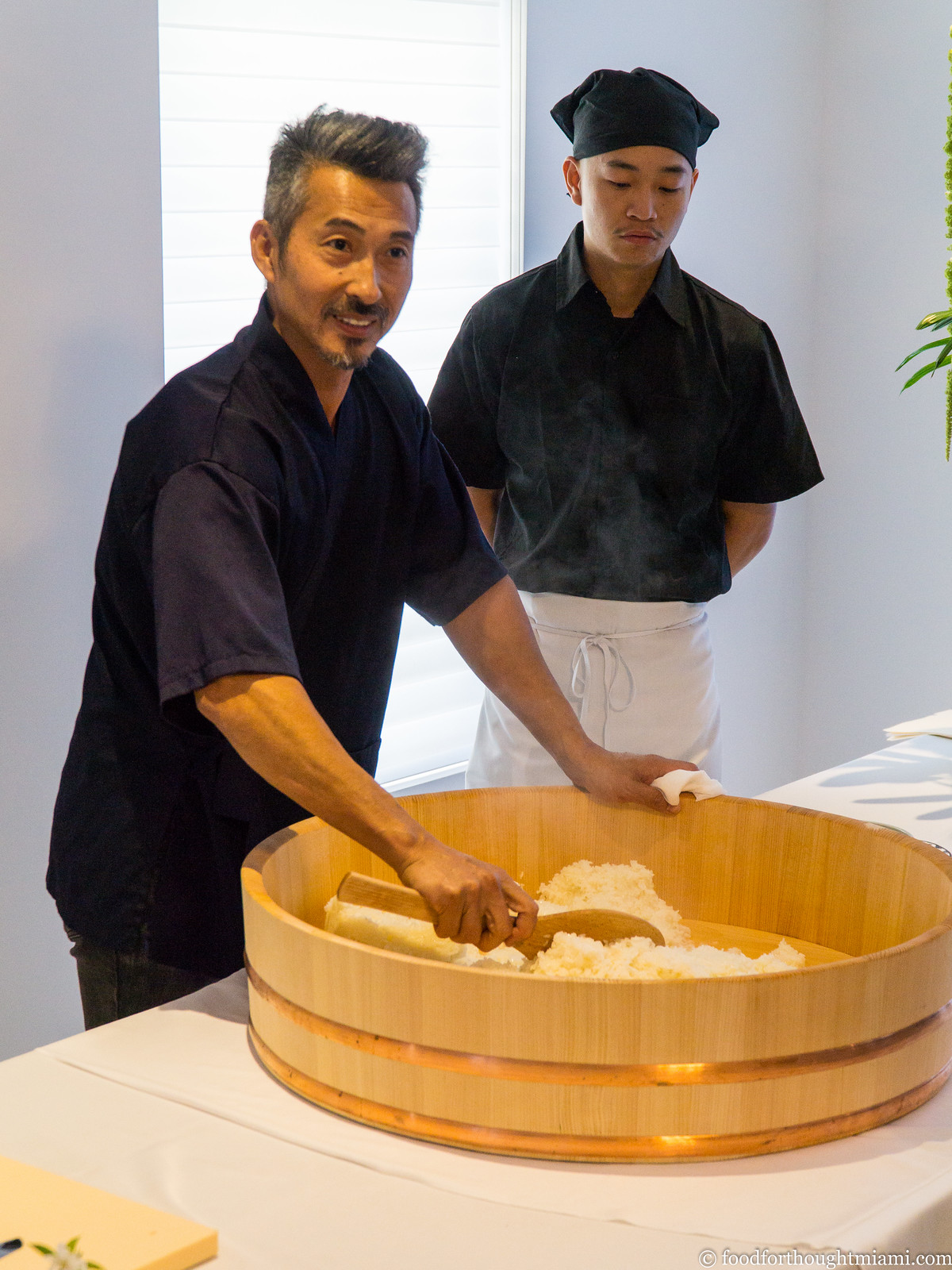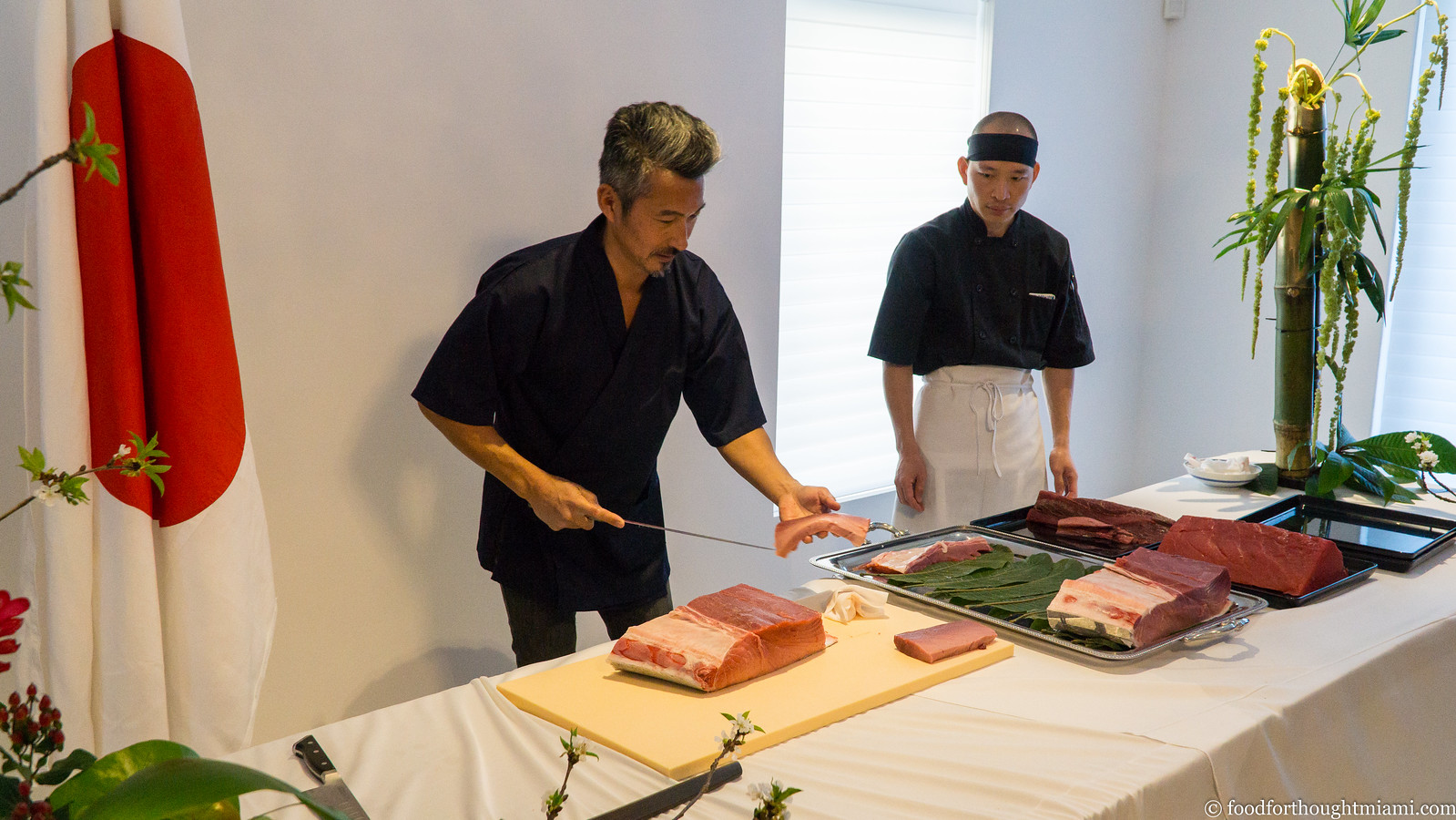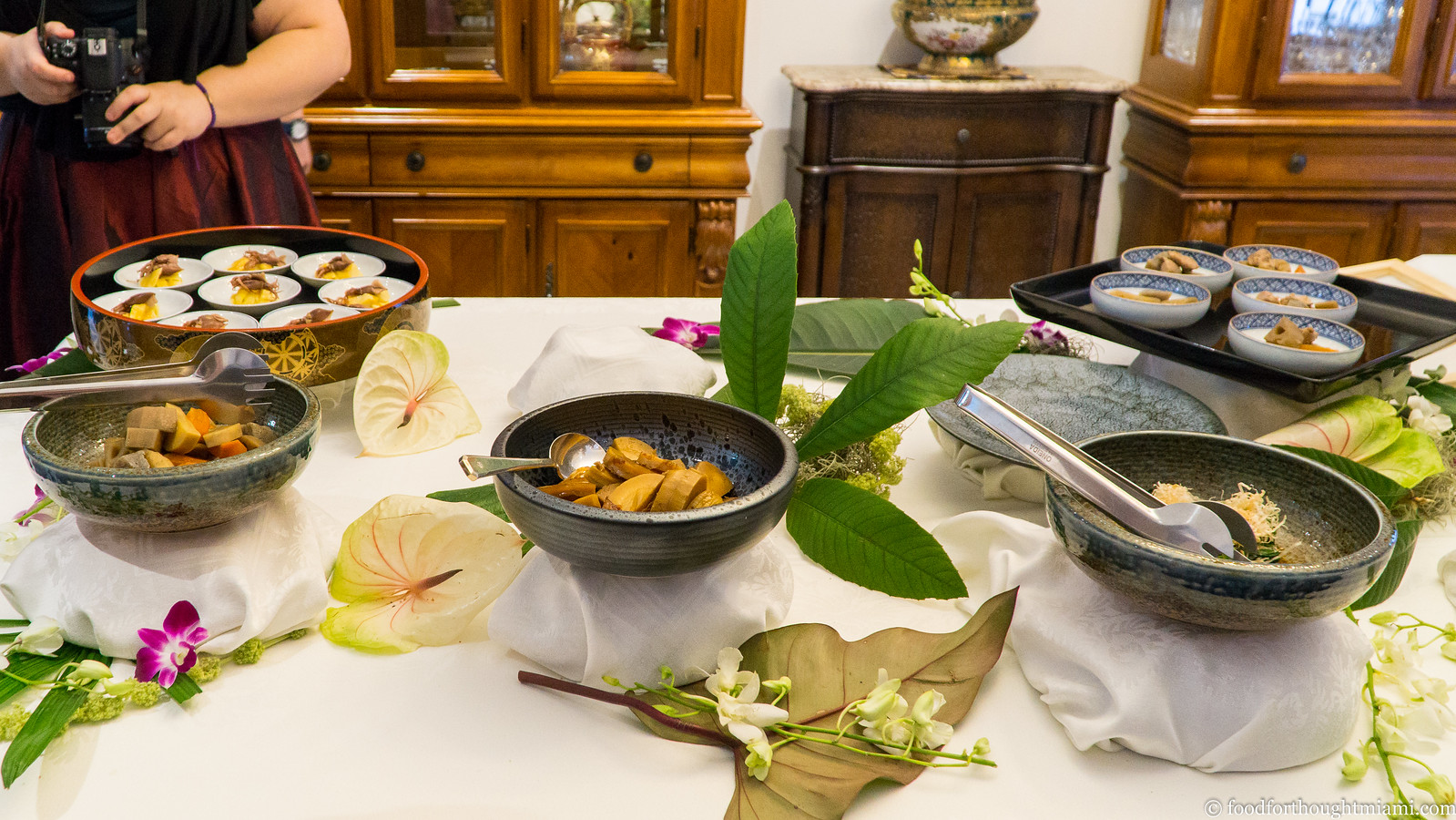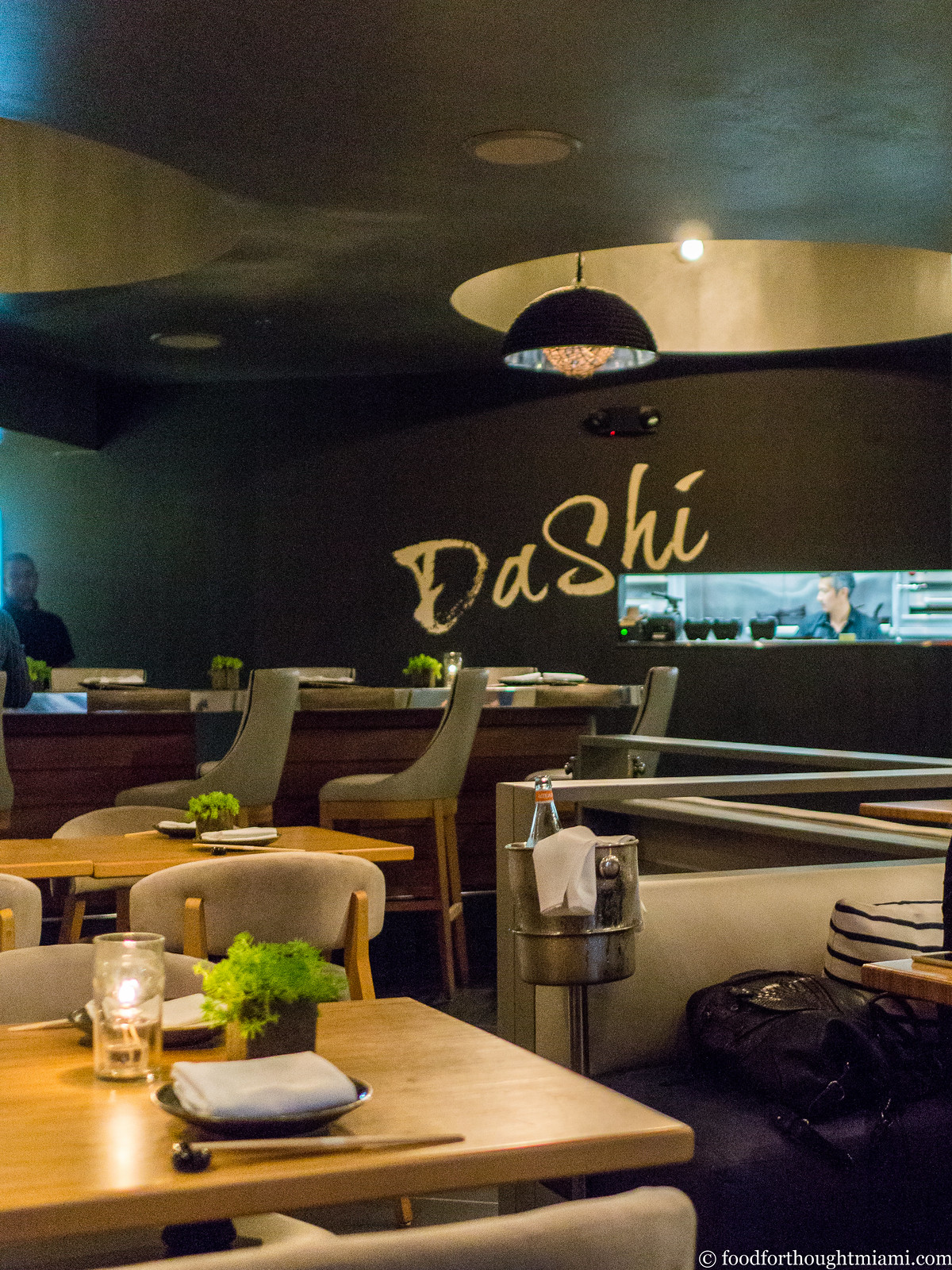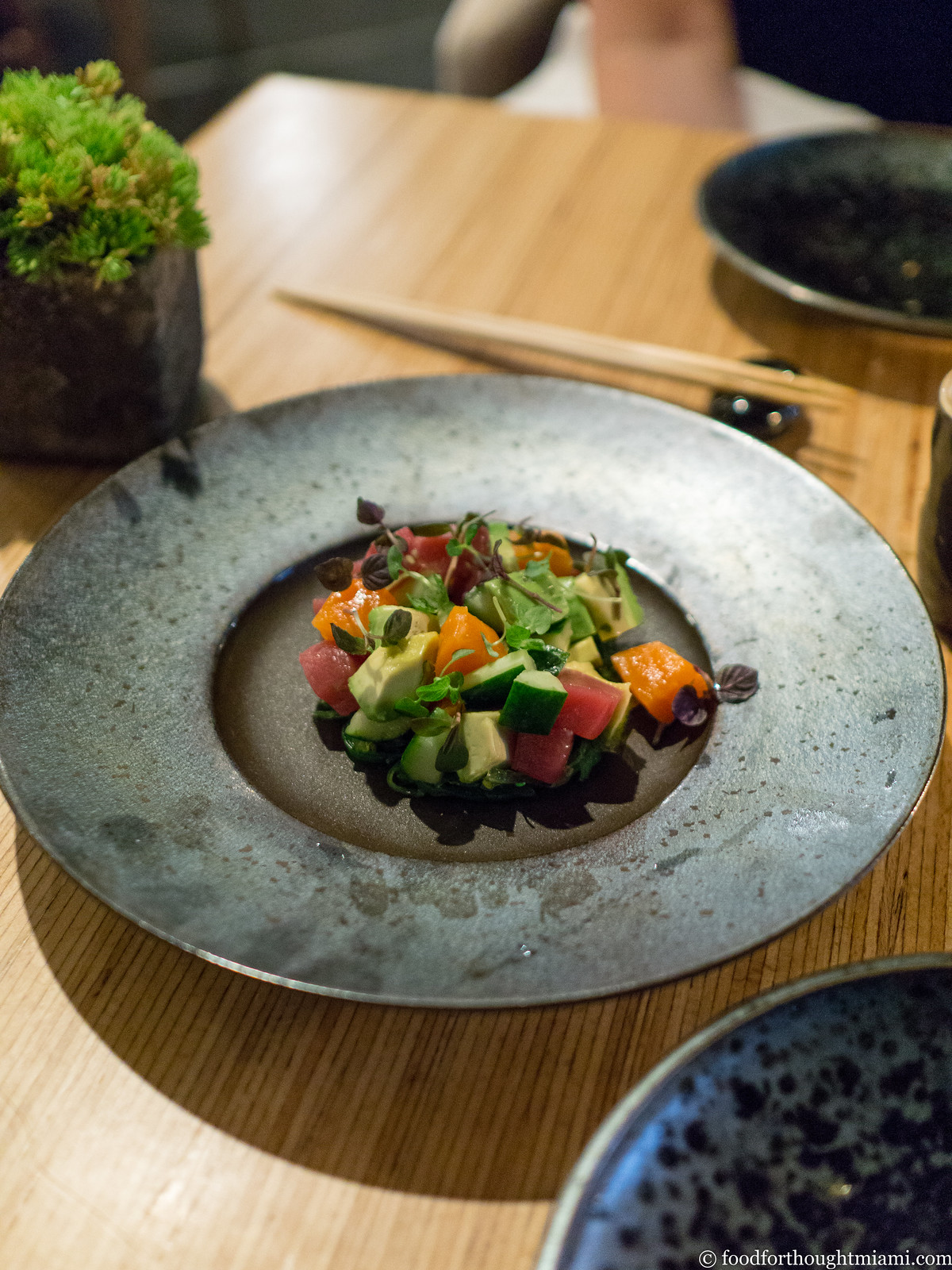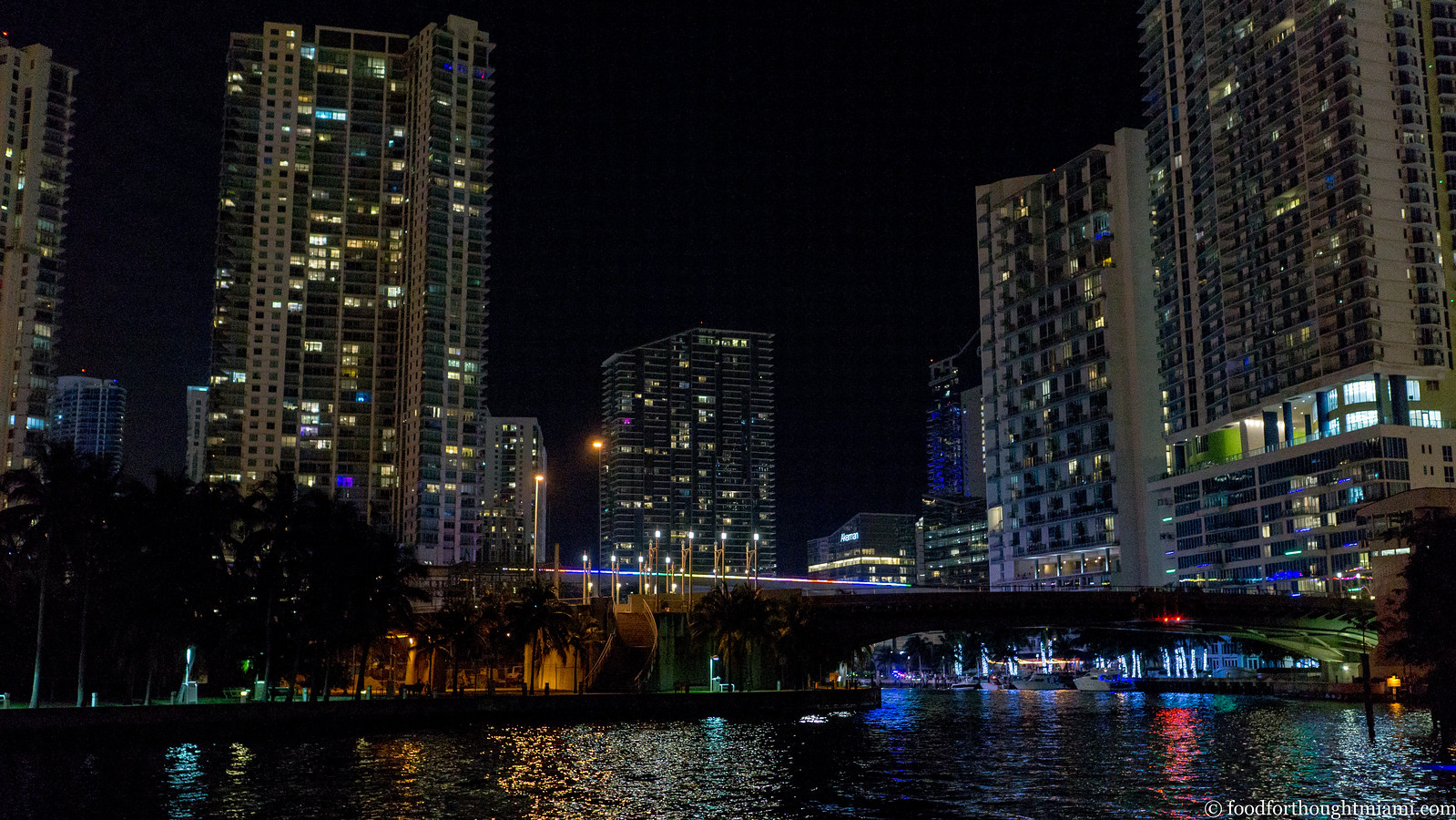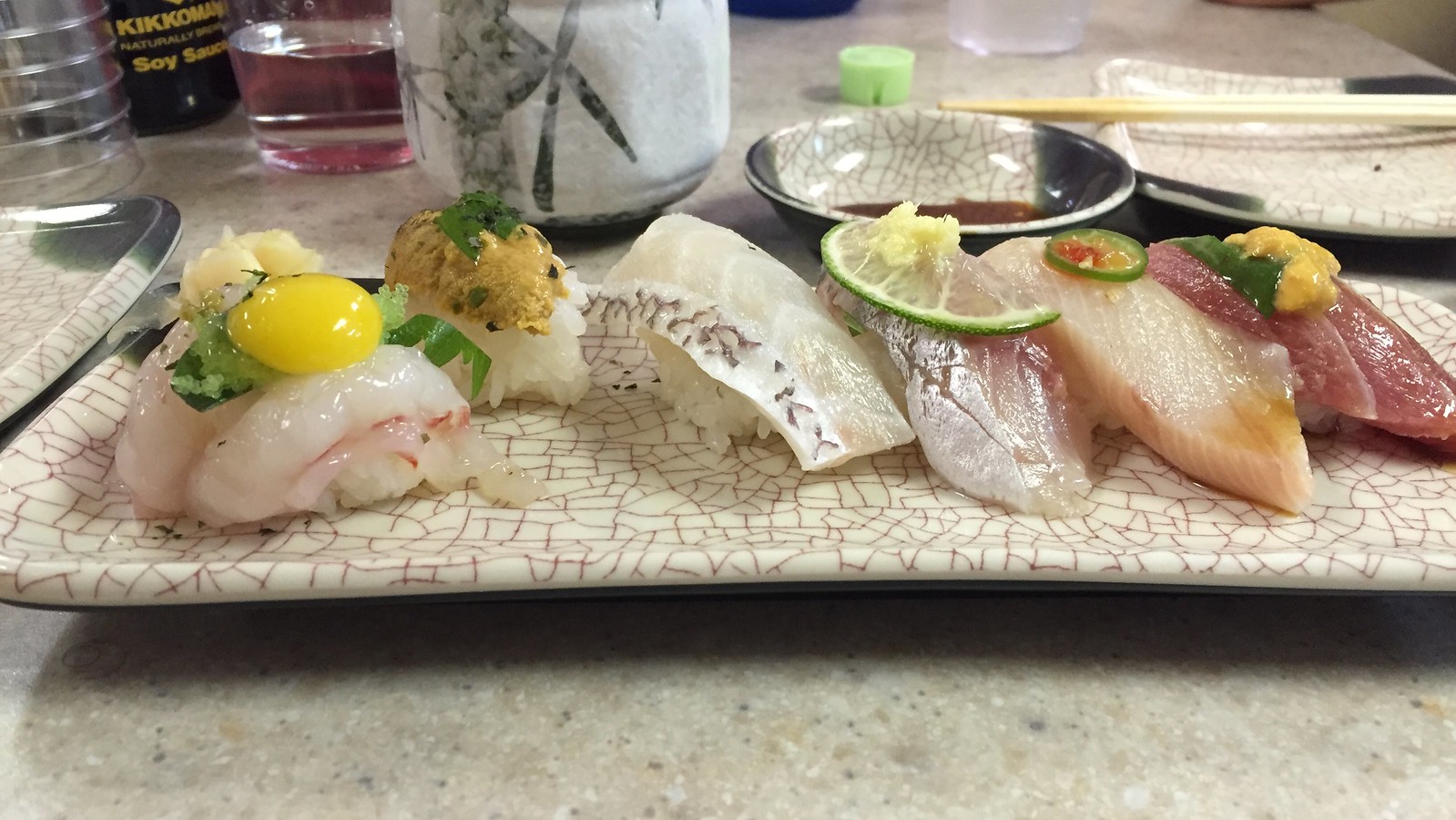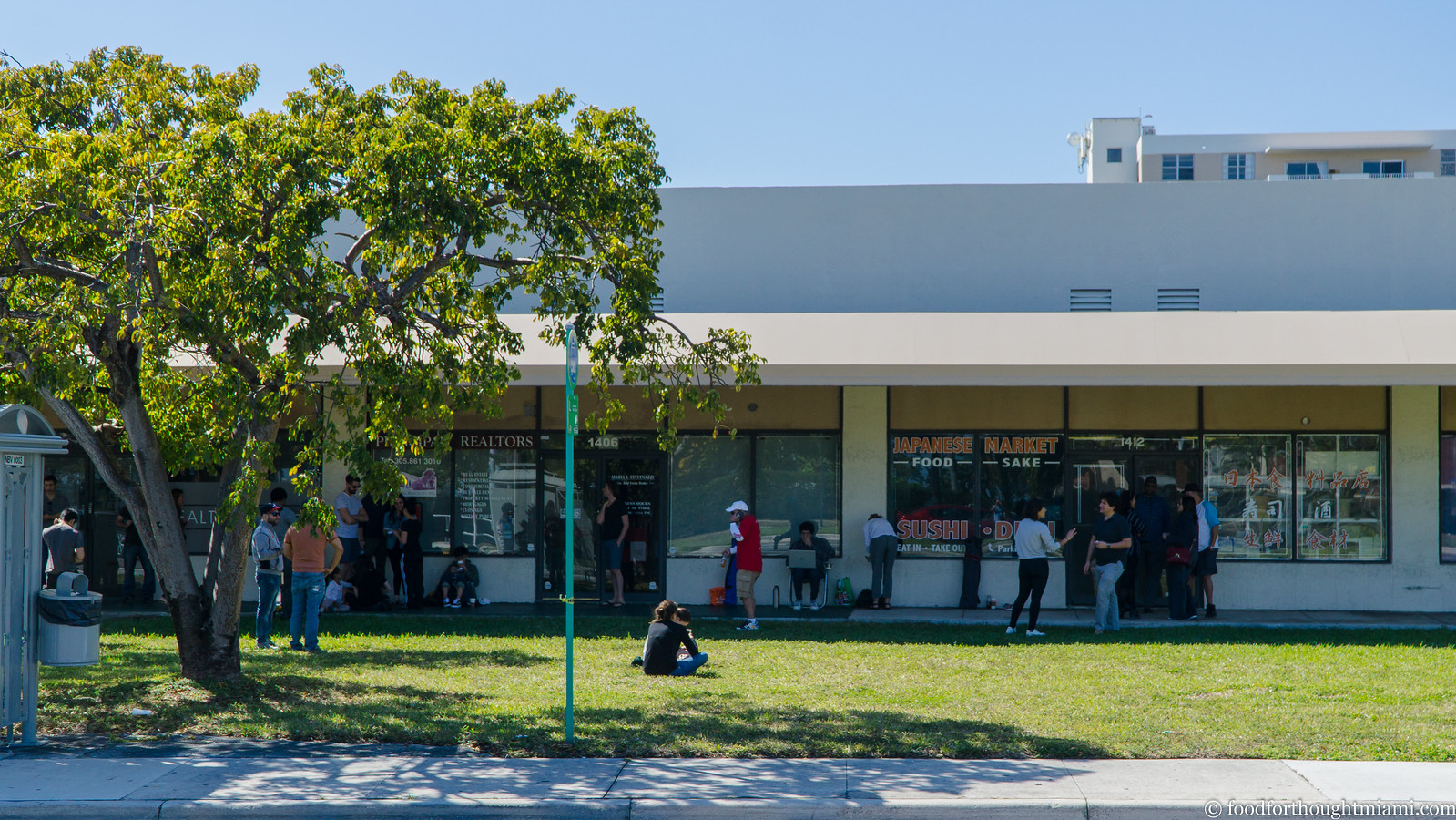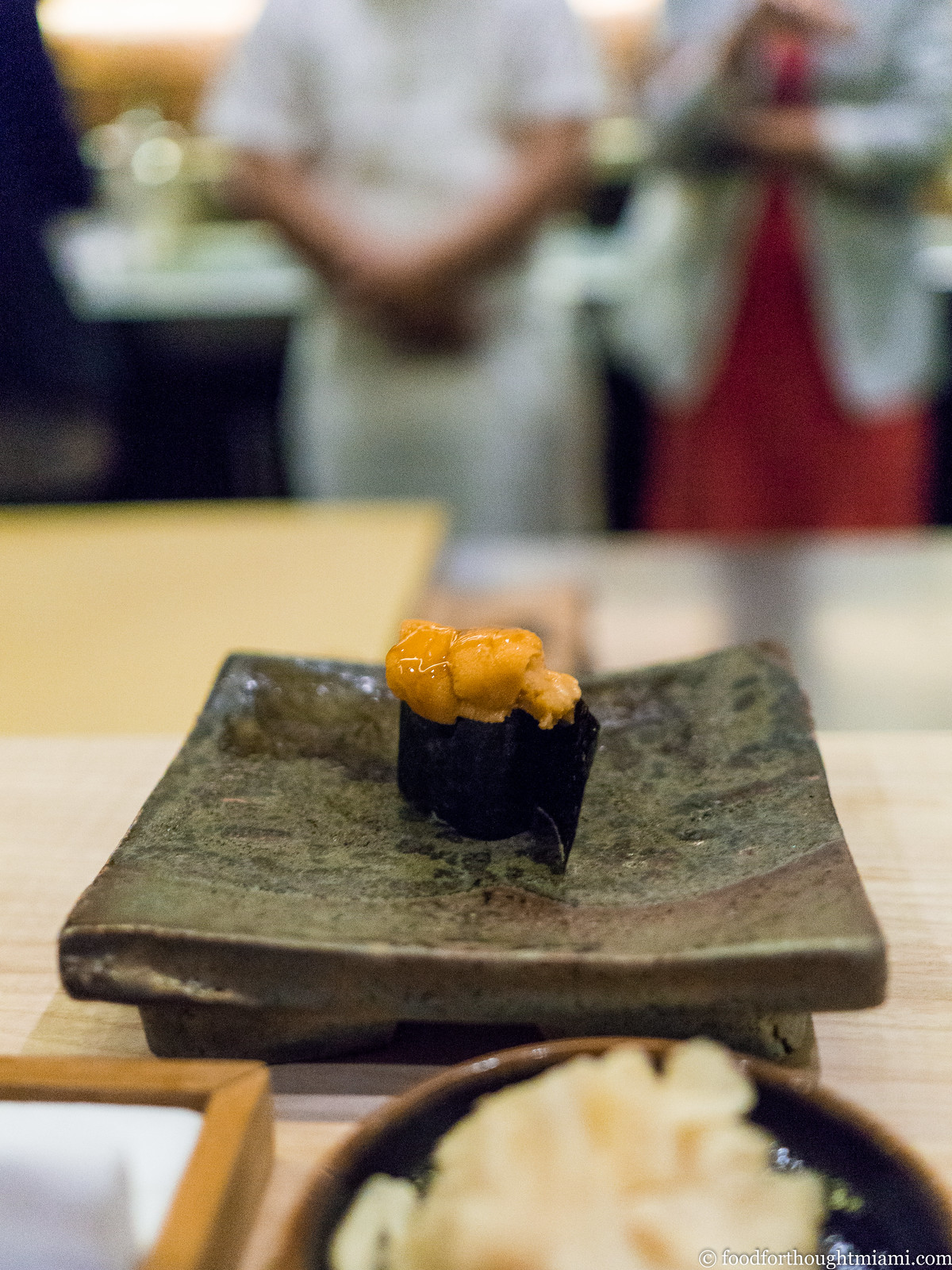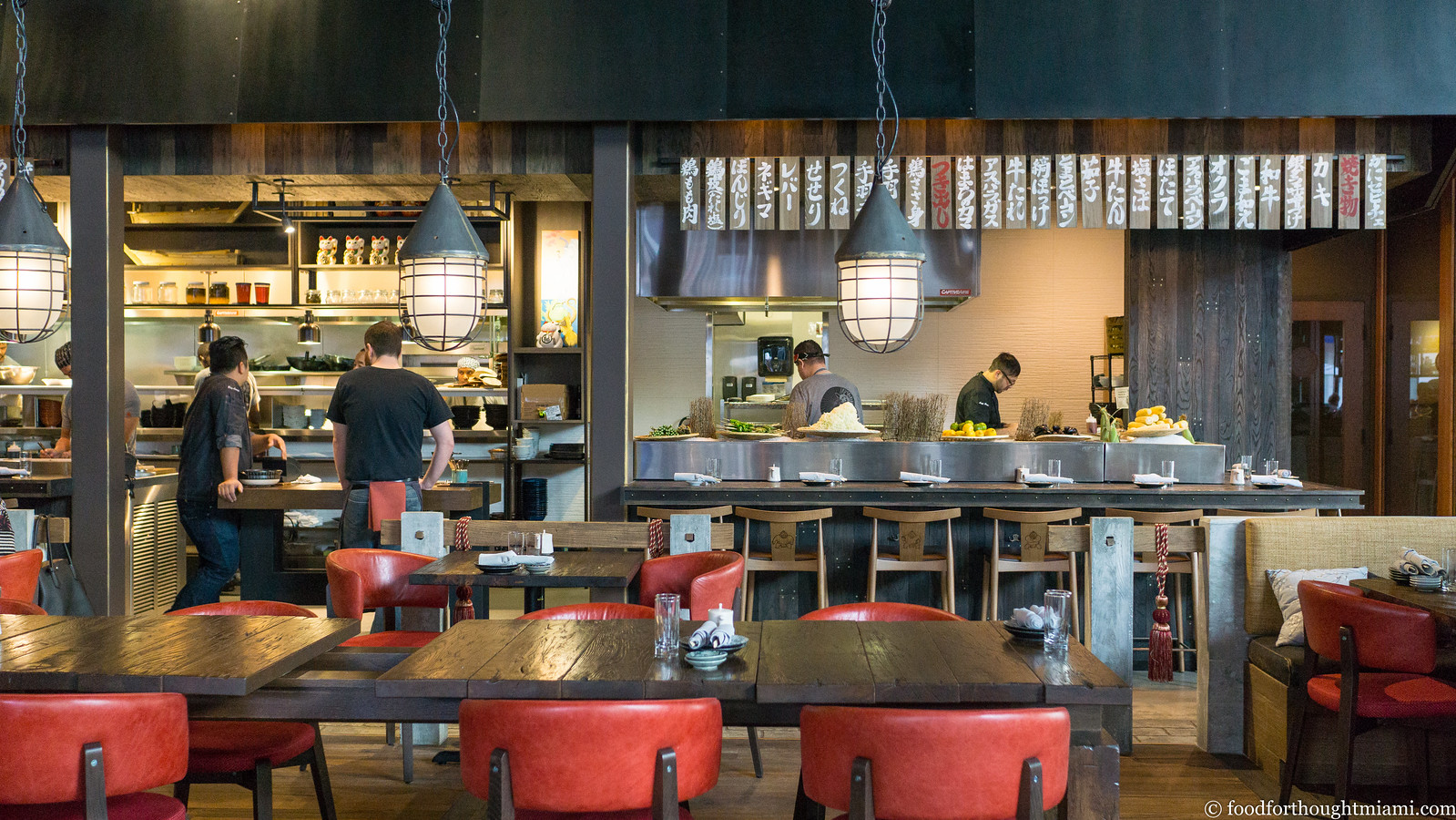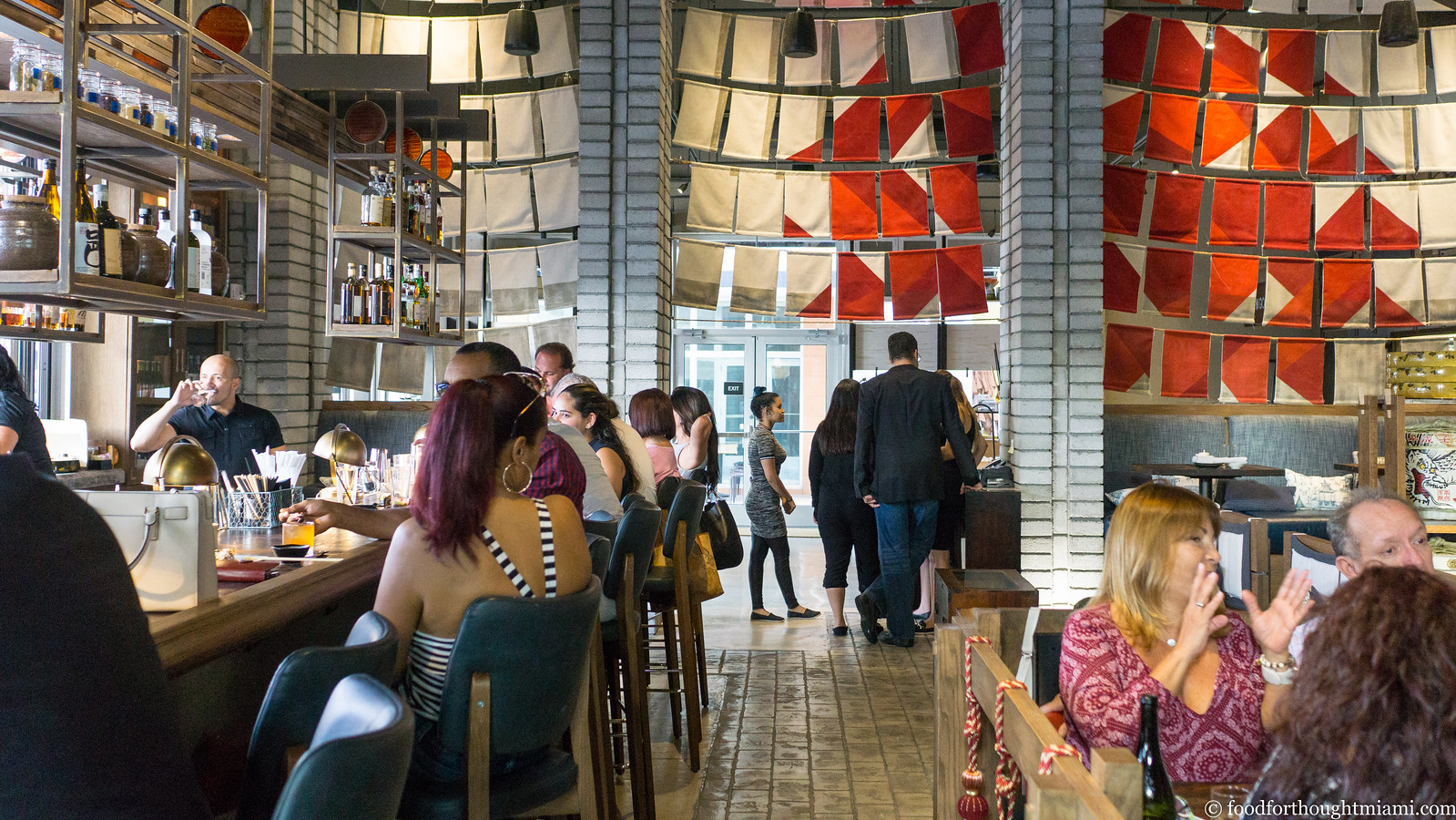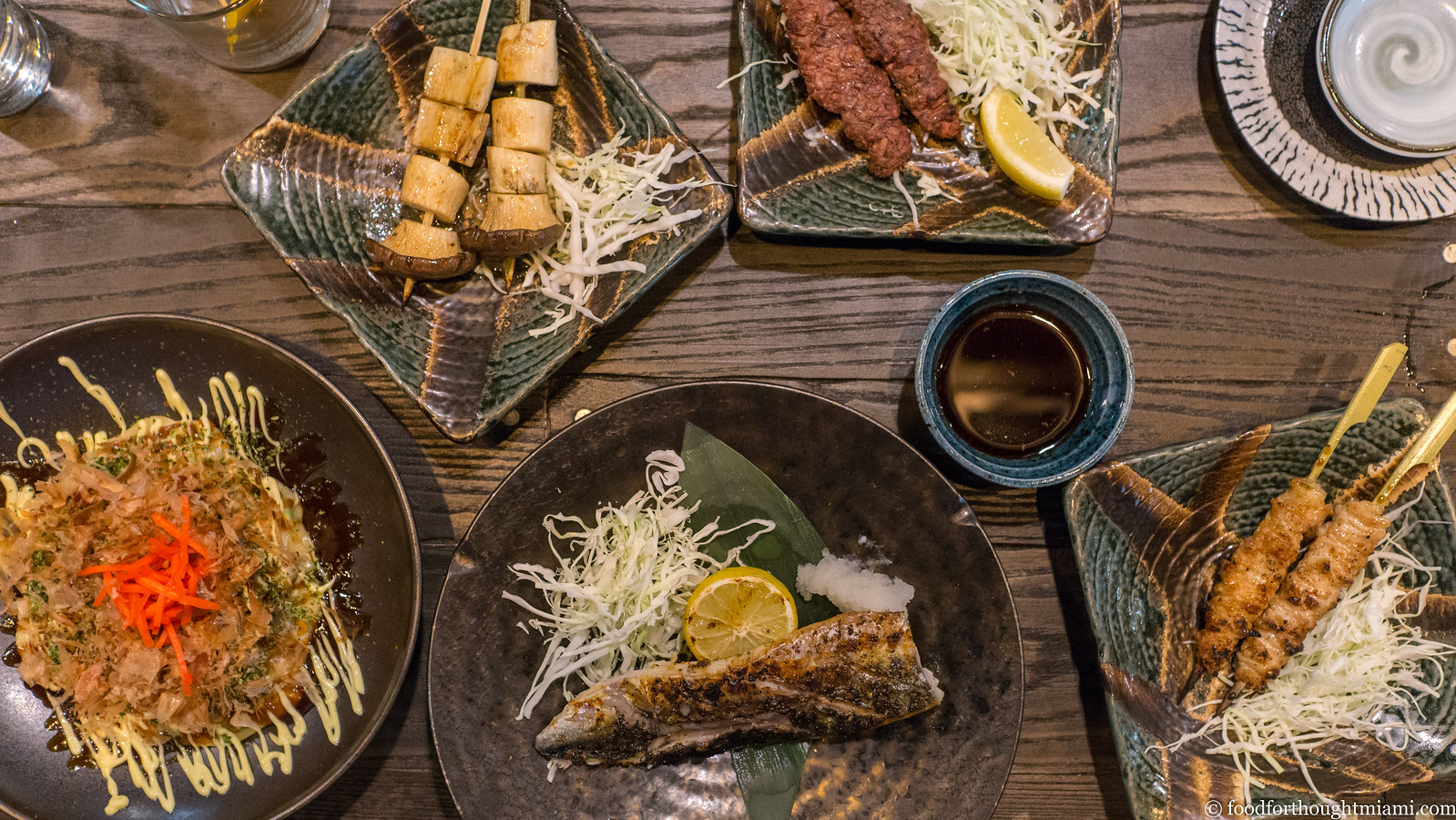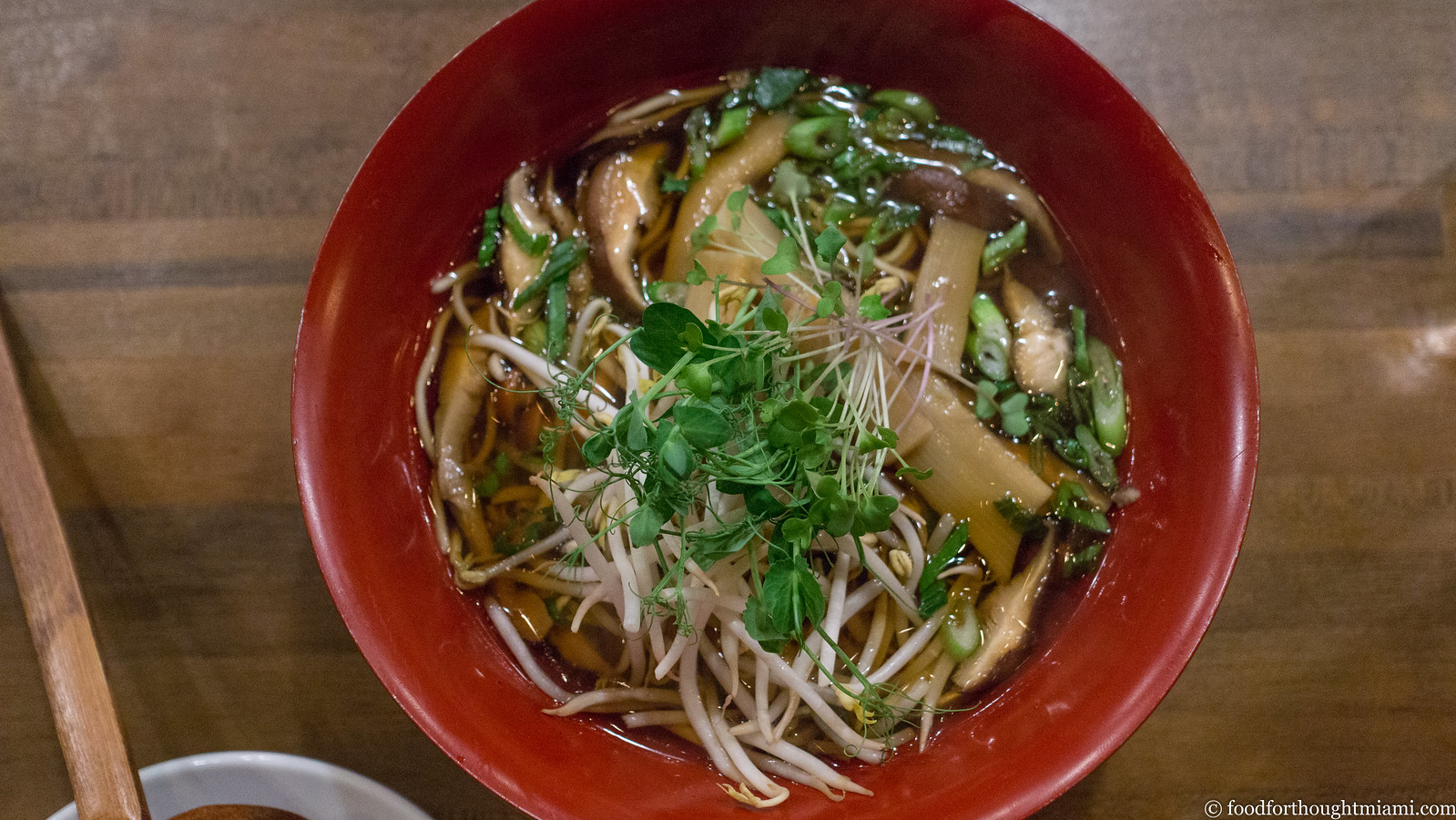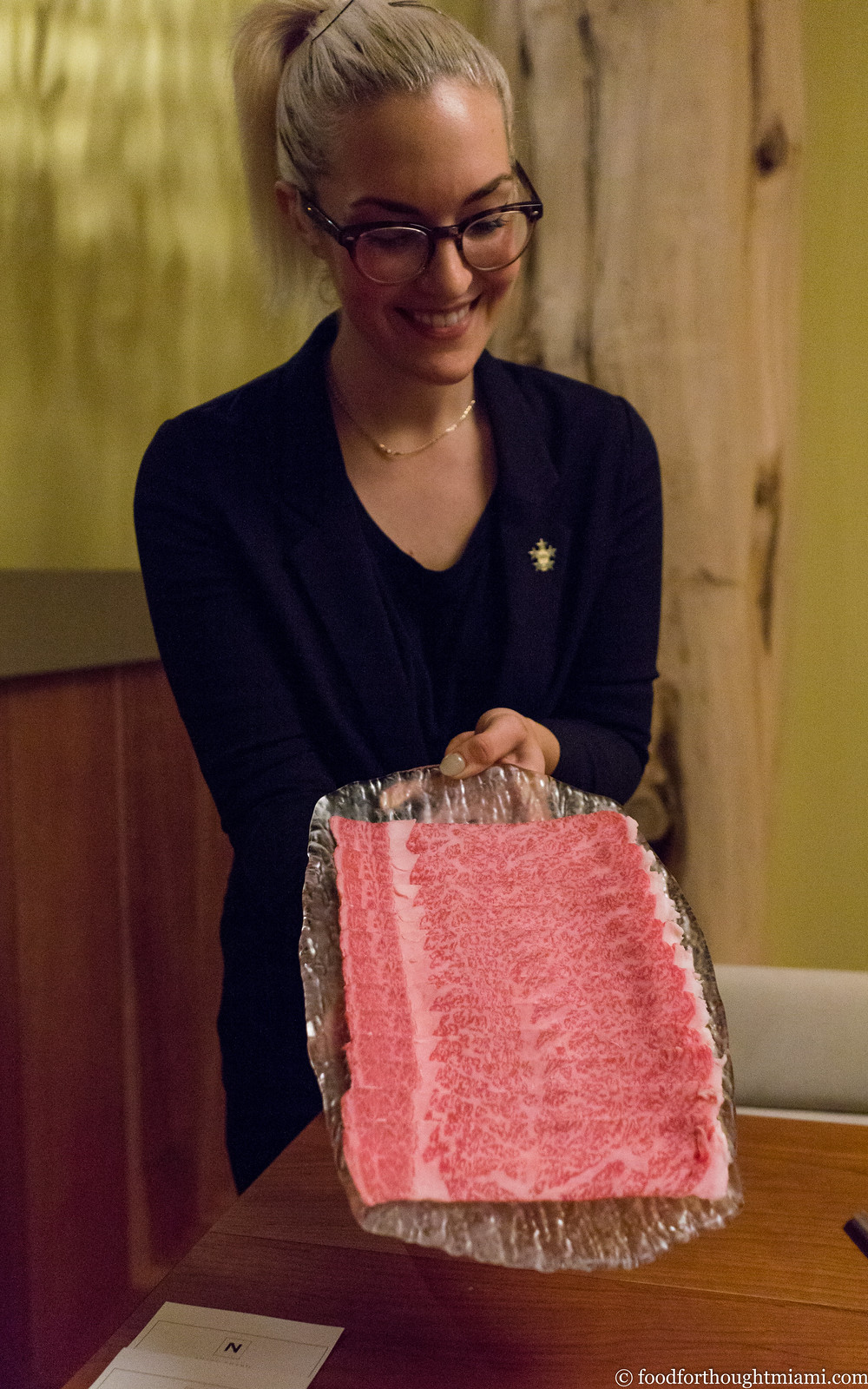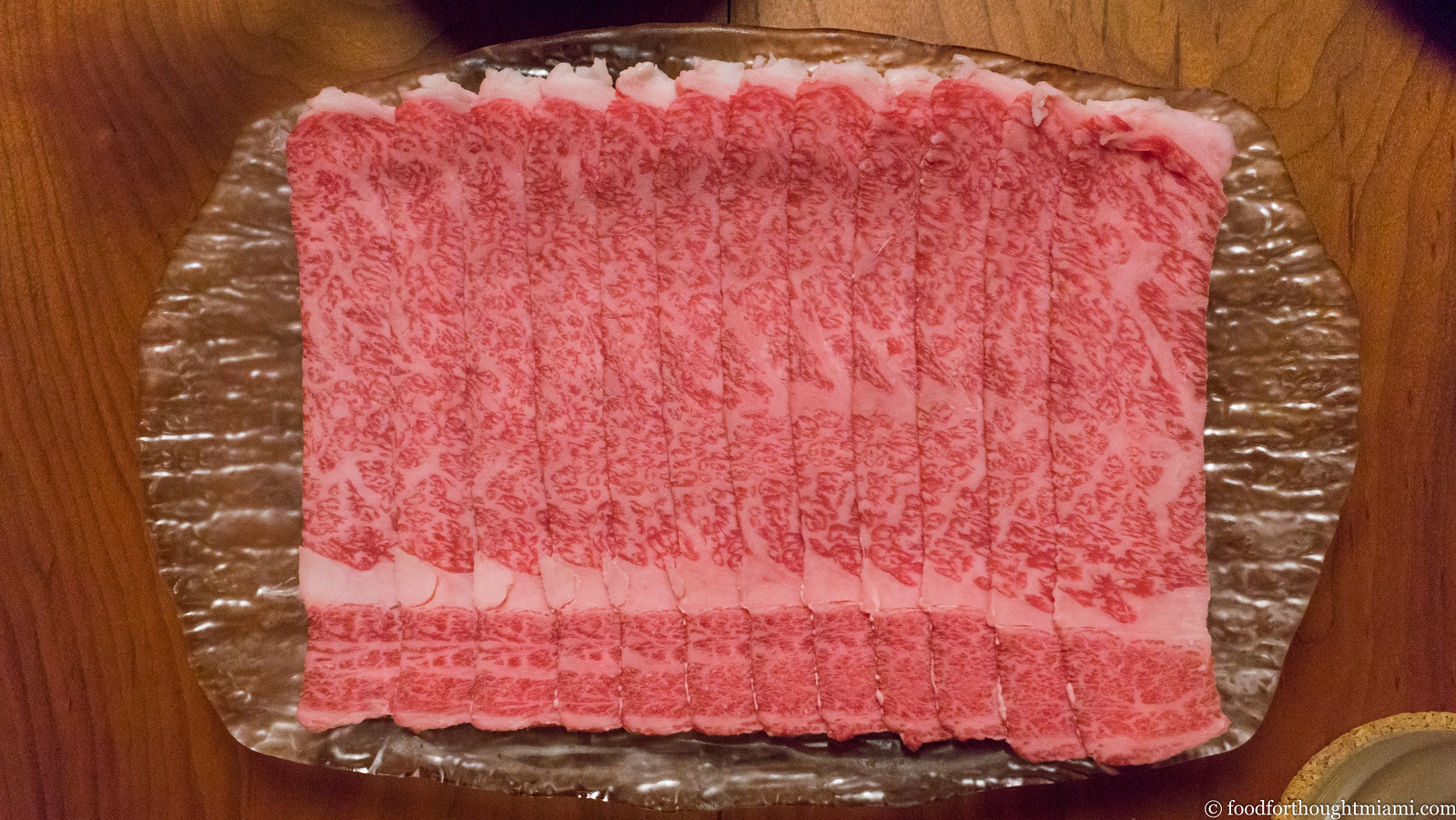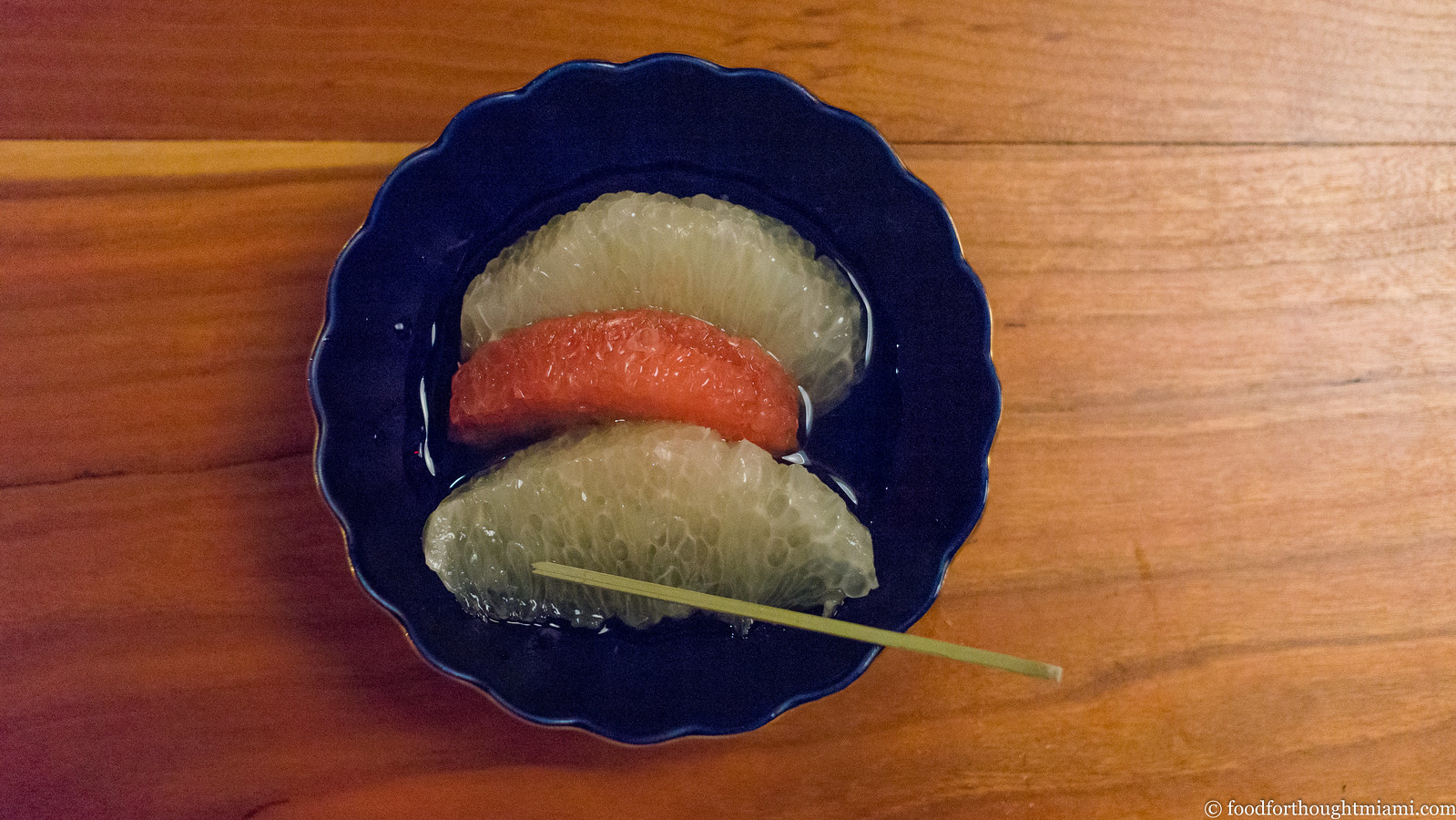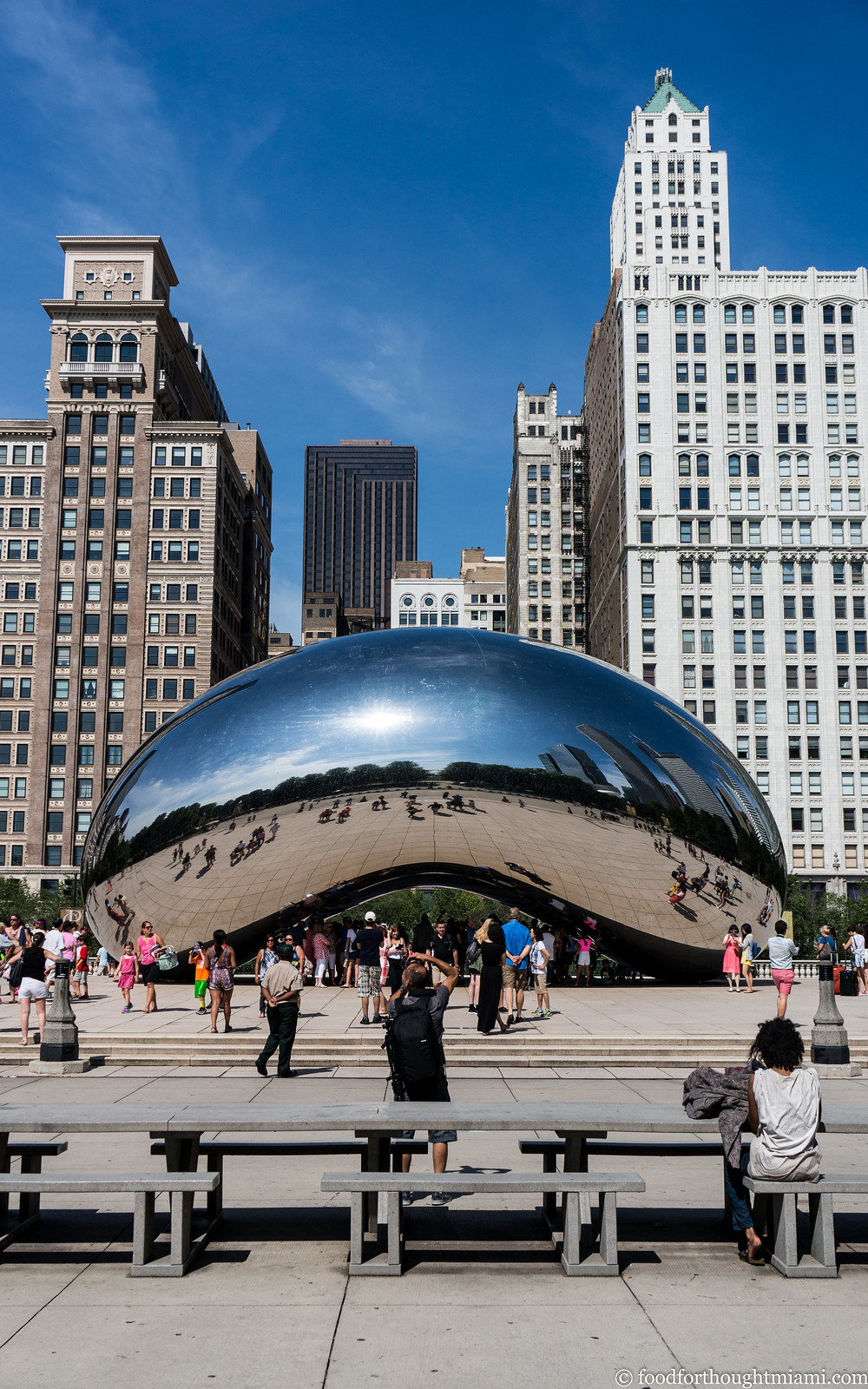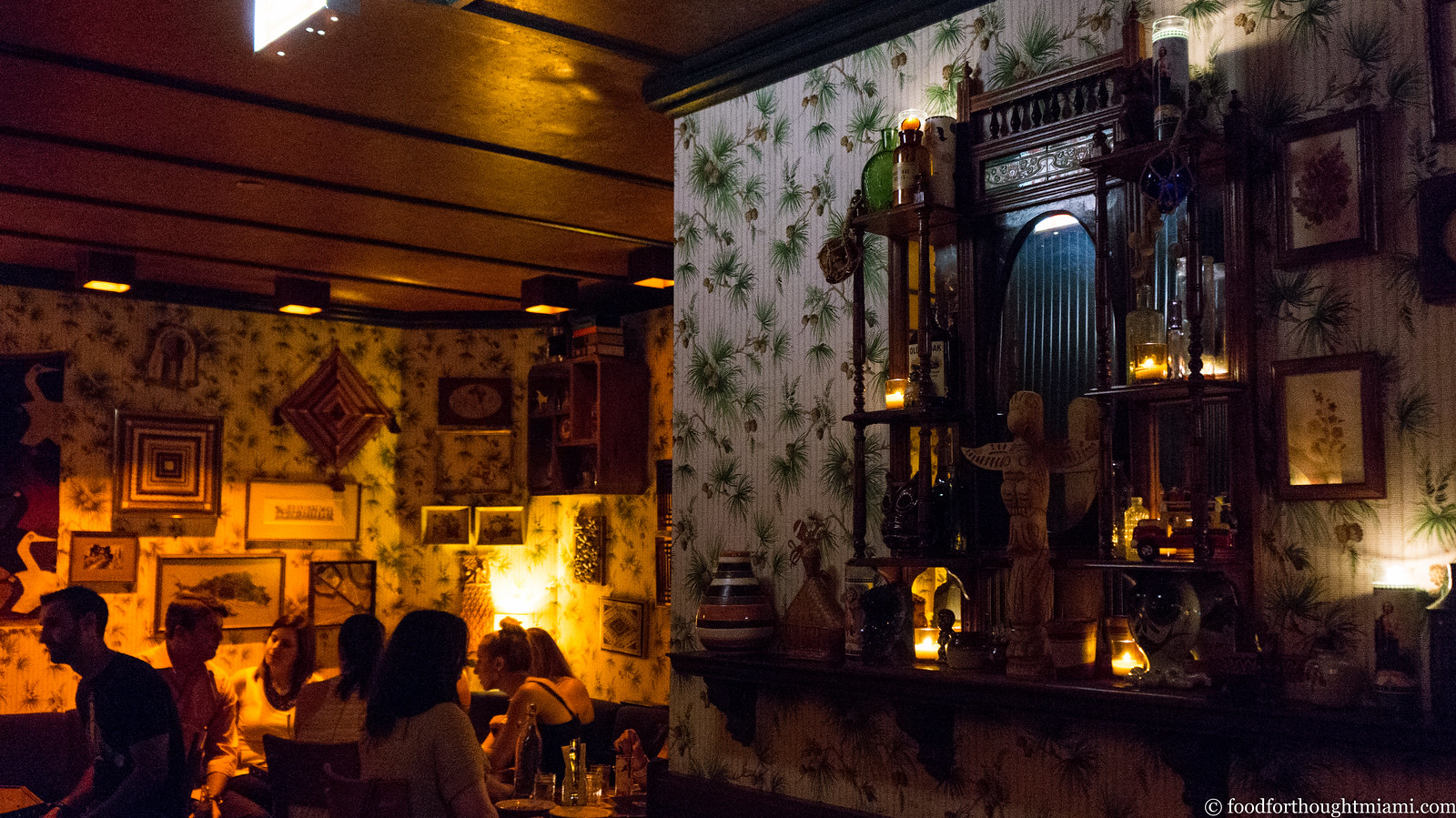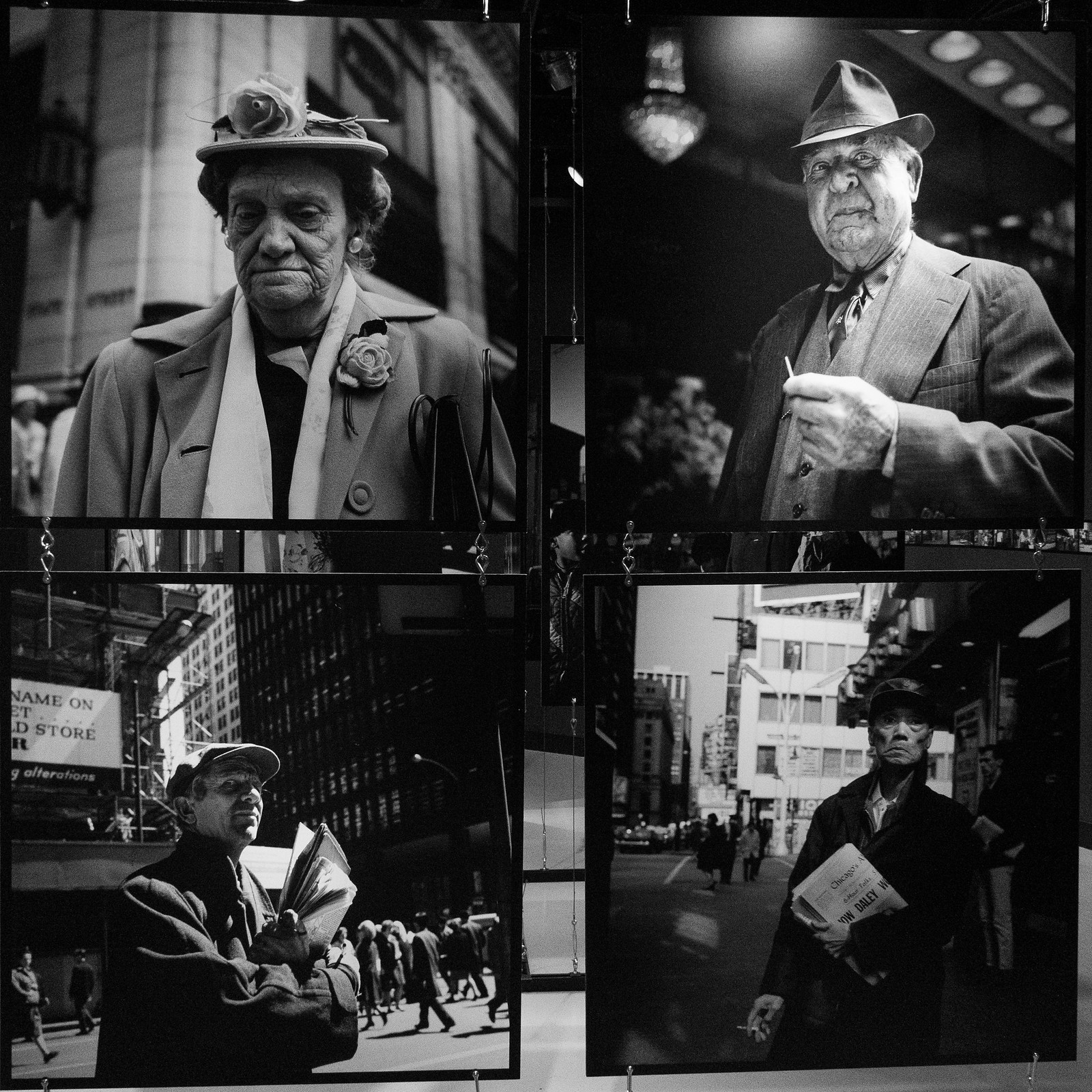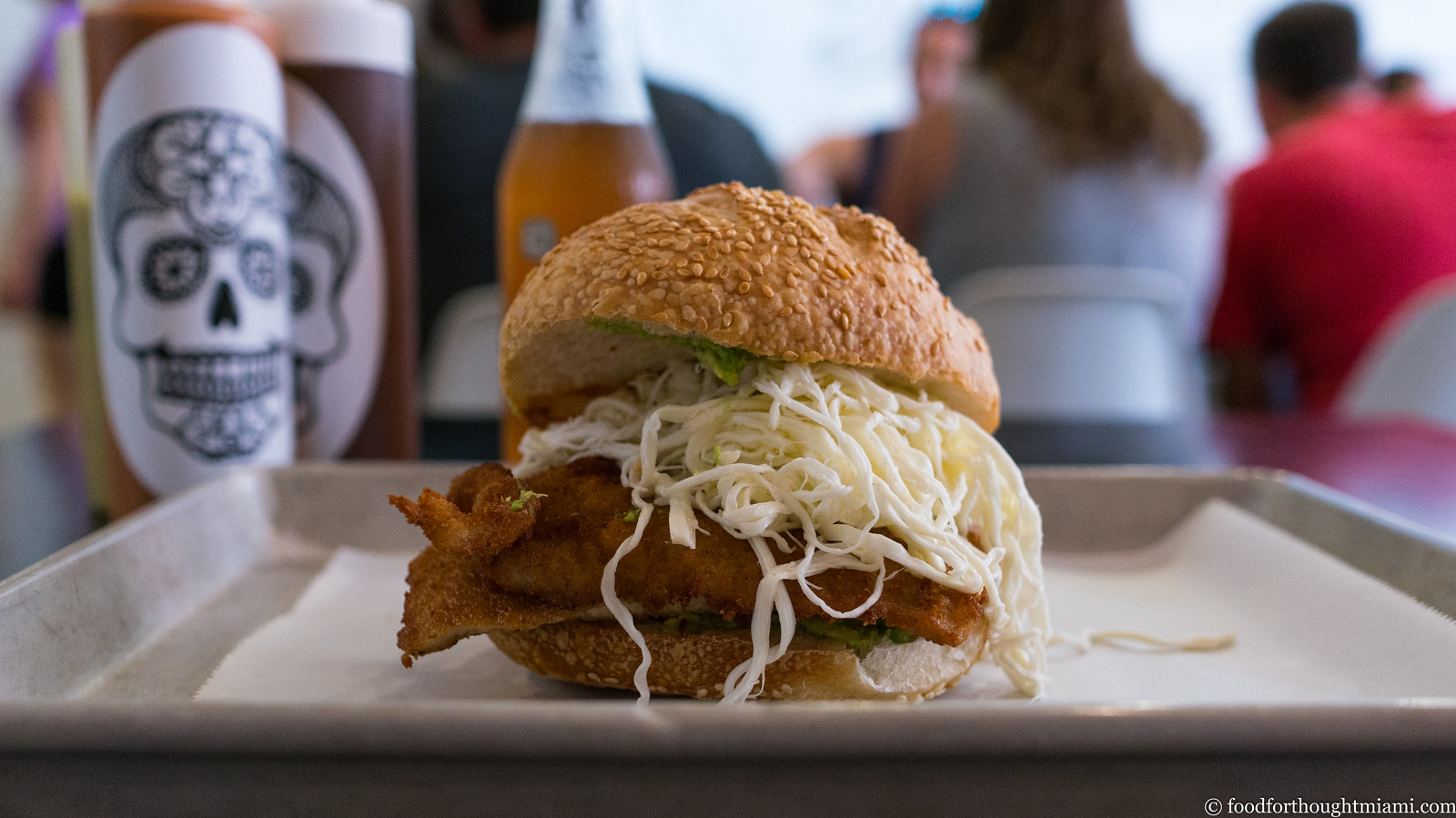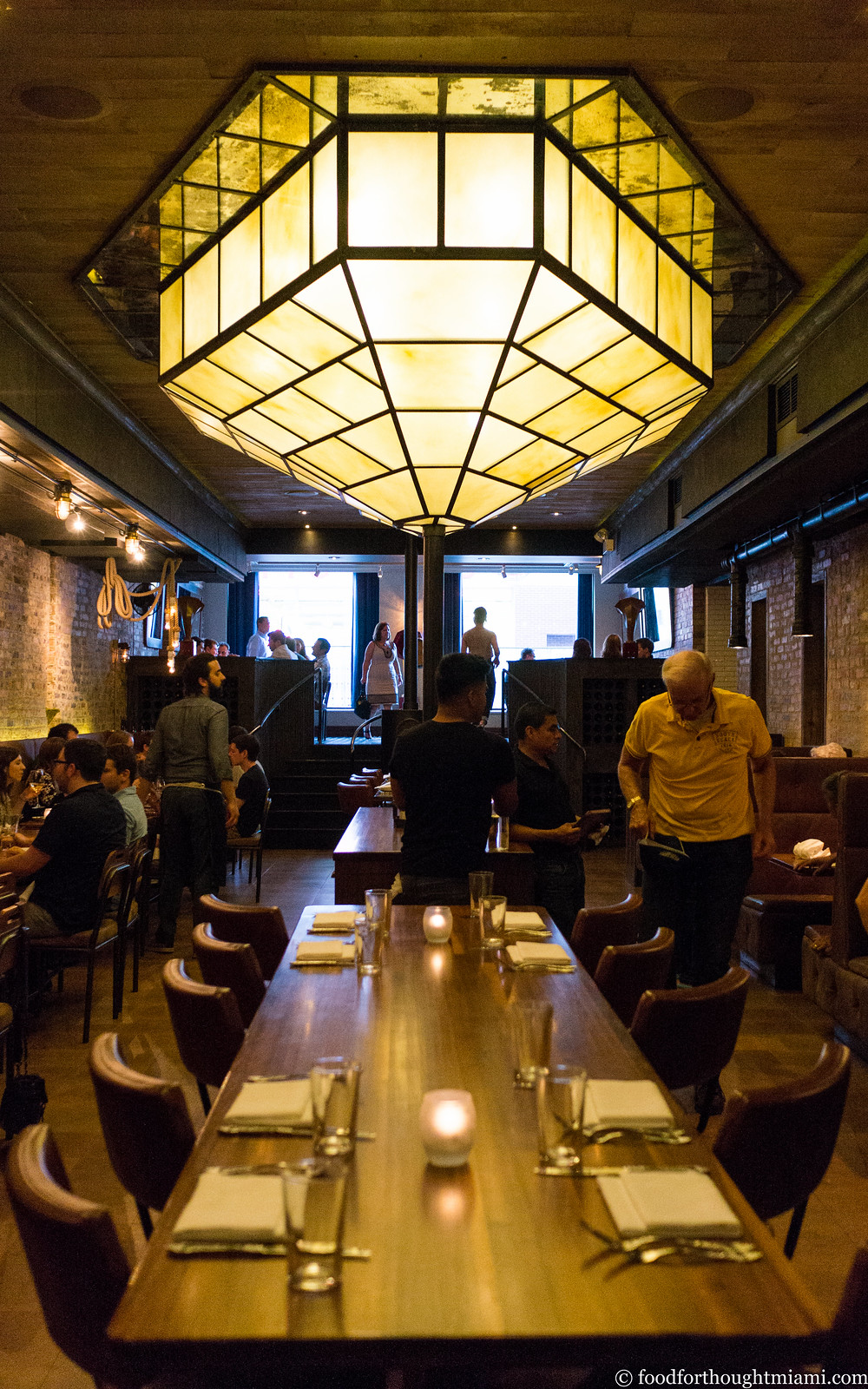I'm a big fan of collaborations. When you put two creative minds together, good things are bound to happen. Yet many "collaborative" dinner events turn out to not really involve all that much actual teamwork. Sure, the chefs will communicate about a menu and ingredients, and decide who is going to do what. But more often than not, they're ping-pong-ing courses back and forth, rather than working together to create dishes that are a genuine combined effort.
Which is one of the things that made our Cobaya dinner last week with chefs Julian Baker of Le Zoo, and Anthony Micari of Makoto, so special: each dish seemed to bear the imprint of both chefs, and both kitchens.
They had some advantages in doing so. The French bistro and contemporary Japanese restaurant are neighbors, both housed in the posh Bal Harbour Shops. They are also siblings of a sort, both under the management of Stephen Starr's Starr Restaurant Group.[1] And they're both Cobaya alumni, in a way: Chef Baker hosted Cobaya Experiment #40 while he was chef at Toscana Divino in Brickell, and Makoto's namesake, head chef Makoto Okuwa, was the host for Cobaya Experiment #32.
For Experiment #75, the two chefs set up a table for thirty of us right between their two restaurants: smack in the middle of the breezeway of Bal Harbour Shops over a glassed-in koi pond that runs through the center. Amidst the shoppers browsing the Dolce & Gabbana couture and Fendi purses, they served a menu that combined, in each dish, the flavors and ingredients and techniques of France and Japan. Here's a recap:
(You can see all my pictures in this Cobaya Le Zoo Makoto flickr set)
Guinea Pigs starting to make their way in for Cobaya Experiment #75.
A snack as guests arrived, and a preview of what's to come: toasted baguettes smeared with a rich, and very French, chicken liver mousse, topped with a zingy, spicy, and very Japanese, yuzu kosho marmalade.
"Toro Niçoise." Chef Micari marinated block cuts of fatty tuna sashimi in soy sauce, toro zuke, style. Chef Baker brought the flavors of the Mediterranean: pickled haricots verts, tomatoes, niçoise olives, slivered radishes, a delicate squash blossom. Someone threw in some fudgy, Szechuan-spiced egg yolk, which was a very good idea. This was a great start.
"Japanese Bouillabaisse." Chef Micari brought some seafood from Tsukiji Market in Tokyo: gorgeous head-on shrimp, silky scallops, delicate baby calamari. It arrived at the table in a bowl with a rice puff rubbed with saffron aioli, the traditional accompaniment to a Provençal bouillabaisse. The dish was then finished with a tableside pour of a rich, heady, spicy seafood stew that had been enriched with red aka miso.
(continued ...)
Showing posts with label Japanese. Show all posts
Showing posts with label Japanese. Show all posts
Wednesday, November 21, 2018
Friday, June 15, 2018
Wabi Sabi by Shuji | Upper East Side (Miami)
My first taste of chef Shuji Hiyakawa's food came at an event last spring hosted by the Japanese Consulate in Miami, described as "Culinary Secrets of Traditional Washoku." "Washoku" literally means "Japanese food," but more specifically, the traditional cuisine of Japan (here's a good primer). After breaking down a whole tuna loin and making sushi of it, Chef Shuji also served a variety of other less heralded Japanese items: a seasonal dish of hotaru ika (firefly squid) with fresh bamboo shoots, yu choy in dashi broth with bonito flakes, sweet soy-braised root vegetables.
At the time, Chef Shuji, who made his way from Fukuoka, Japan to Miami by way of Philadelphia, where he had worked for several years as executive sushi chef for Morimoto, was weeks away from opening his own restaurant, Dashi. I went to Dashi shortly after it opened (you can read my first thoughts) and came away pretty impressed, albeit dismayed by the absence of a conventional sushi bar. But Dashi closed only a few months later after Hurricane Irma caused extensive damage to the River Yacht Club, where the restaurant was situated.
Fortunately, Chef Shuji had a back-up plan. Turns out he was already at work on another concept in a different space – and even better (for me, anyway), it was right along the path of my daily commute, in Miami's "Upper East Side" on N.E. 79th Street just over the Causeway from Miami Beach. In early January, Wabi Sabi by Shuji opened.
(You can see all my pictures in this Wabi Sabi by Shuji flickr set).
It's a simple but striking space, built out and decorated almost entirely by Chef Shuji himself. Across one wall sprawls a flock of multi-colored origami cranes. A table underneath is laid out with enough beautiful Japanese ceramics to serve a feast for about ten people (more on that later). Hanging from the ceiling and resting on counters are an abundance of kokedama moss ball planters. A few rough wood tables provide seating for maybe a dozen diners. At the back, there's a small kitchen island where you'll find Chef Shuji and assistant chef Maggie Hyams working away, and on some days, marketing and event coordinator Koko Makoto working the register, serving as hostess, and doing everything else that needs doing with grace and charm.
There's still no sushi bar. Rather, the idea of Wabi Sabi combines some Japanese tradition with the latest in American fast-casual trends: food in bowls. We all love food in bowls these days. Buddha bowls, poke bowls, power bowls, acai bowls – seems we'll eat anything if you put it in a bowl.[1] While some food trends are just plain stupid, this is one I can get behind: it's convenient, it's right-sized portioning, and when you put nice things in the bowl, it can be both delicious and aesthetically pleasing.
Which are also some of the things I love about Wabi Sabi. The menu at Wabi Sabi is straightforward: a choice of four different combinations of raw fish and accompaniments, over a choice of four different bases (sushi rice, a multigrain mixture, green tea soba noodles, or salad greens), with a choice of four different sauces – served in a bowl.[2] Any of the basic configurations will run you between $11 (for a vegetarian version which includes cucumber, avocado, scallion, seaweed salad, soy-marinated shiitake mushrooms, carrots and radishes) and $18 (for a fully decked out version with tuna, salmon, lump crab, tobiko, and an assortment of vegetables).
Or, for the ballers out there, there's also an "omakase" bowl, which features an ever-changing assortment of fish and seafood, much of it flown in straight from Tsukiji Market in Japan, served chirashi style over seasoned rice. That may mean blocks of fatty hamachi (yellotwail), ribbons of silky, clean kinmedai (golden-eye snapper), shimmering sayori (half-beak), creamy uni (sea urchin), silver-skinned aji (horse mackerel), house-cured iwashi (sardine) or kohada (gizzard shad), baubles of ikura (salmon roe), or any number of other possibilities, served over a bowl of seasoned rice, with seaweed salad, maybe some sprouts, maybe some soy-cured shiitake mushrooms, and a scatter of shredded nori batons.
Unlike the standard menu options, the omakase bowl is not cheap – pricing usually runs between $35 and $40, depending on what ingredients are featured that particular day. But if you add up what you would pay for a comparable sashimi or sushi order at any good sushi-ya – and the quality of the ingredients at Wabi Sabi is on par with what you'll find at the few places in Miami that fit that description – I think you'll find it to be roughly equivalent. It is also probably the easiest, most convenient way to eat some great sushi that you'll find in Miami, one that you can even take home and eat in front of the TV if you wish.
(continued ...)
At the time, Chef Shuji, who made his way from Fukuoka, Japan to Miami by way of Philadelphia, where he had worked for several years as executive sushi chef for Morimoto, was weeks away from opening his own restaurant, Dashi. I went to Dashi shortly after it opened (you can read my first thoughts) and came away pretty impressed, albeit dismayed by the absence of a conventional sushi bar. But Dashi closed only a few months later after Hurricane Irma caused extensive damage to the River Yacht Club, where the restaurant was situated.
Fortunately, Chef Shuji had a back-up plan. Turns out he was already at work on another concept in a different space – and even better (for me, anyway), it was right along the path of my daily commute, in Miami's "Upper East Side" on N.E. 79th Street just over the Causeway from Miami Beach. In early January, Wabi Sabi by Shuji opened.
(You can see all my pictures in this Wabi Sabi by Shuji flickr set).
It's a simple but striking space, built out and decorated almost entirely by Chef Shuji himself. Across one wall sprawls a flock of multi-colored origami cranes. A table underneath is laid out with enough beautiful Japanese ceramics to serve a feast for about ten people (more on that later). Hanging from the ceiling and resting on counters are an abundance of kokedama moss ball planters. A few rough wood tables provide seating for maybe a dozen diners. At the back, there's a small kitchen island where you'll find Chef Shuji and assistant chef Maggie Hyams working away, and on some days, marketing and event coordinator Koko Makoto working the register, serving as hostess, and doing everything else that needs doing with grace and charm.
There's still no sushi bar. Rather, the idea of Wabi Sabi combines some Japanese tradition with the latest in American fast-casual trends: food in bowls. We all love food in bowls these days. Buddha bowls, poke bowls, power bowls, acai bowls – seems we'll eat anything if you put it in a bowl.[1] While some food trends are just plain stupid, this is one I can get behind: it's convenient, it's right-sized portioning, and when you put nice things in the bowl, it can be both delicious and aesthetically pleasing.
Which are also some of the things I love about Wabi Sabi. The menu at Wabi Sabi is straightforward: a choice of four different combinations of raw fish and accompaniments, over a choice of four different bases (sushi rice, a multigrain mixture, green tea soba noodles, or salad greens), with a choice of four different sauces – served in a bowl.[2] Any of the basic configurations will run you between $11 (for a vegetarian version which includes cucumber, avocado, scallion, seaweed salad, soy-marinated shiitake mushrooms, carrots and radishes) and $18 (for a fully decked out version with tuna, salmon, lump crab, tobiko, and an assortment of vegetables).
Or, for the ballers out there, there's also an "omakase" bowl, which features an ever-changing assortment of fish and seafood, much of it flown in straight from Tsukiji Market in Japan, served chirashi style over seasoned rice. That may mean blocks of fatty hamachi (yellotwail), ribbons of silky, clean kinmedai (golden-eye snapper), shimmering sayori (half-beak), creamy uni (sea urchin), silver-skinned aji (horse mackerel), house-cured iwashi (sardine) or kohada (gizzard shad), baubles of ikura (salmon roe), or any number of other possibilities, served over a bowl of seasoned rice, with seaweed salad, maybe some sprouts, maybe some soy-cured shiitake mushrooms, and a scatter of shredded nori batons.
Unlike the standard menu options, the omakase bowl is not cheap – pricing usually runs between $35 and $40, depending on what ingredients are featured that particular day. But if you add up what you would pay for a comparable sashimi or sushi order at any good sushi-ya – and the quality of the ingredients at Wabi Sabi is on par with what you'll find at the few places in Miami that fit that description – I think you'll find it to be roughly equivalent. It is also probably the easiest, most convenient way to eat some great sushi that you'll find in Miami, one that you can even take home and eat in front of the TV if you wish.
(continued ...)
Monday, August 7, 2017
first thoughts: Gaijin Izakaya by Cake | Midtown Miami
A couple years ago I got pretty excited over a tiny storefront along Biscayne Boulevard serving possibly the best Thai food I'd eaten in South Florida: Cake Thai Kitchen. Since then, Chef Cake (a/k/a Phuket Thongsodchareondee) has gone on to open a second, more polished Cake Thai in Wynwood, and has plans in the works for another location in the Citadel, a food hall and multi-purpose space currently in development in Little Haiti. It's been wonderful to watch the ascent of a chef whose talent is matched only by his humility.
And now, he's doing something else: a Japanese style izakaya in the Midtown Miami space of "The Gang," which he's calling "Gaijin Izakaya by Cake."[1] It's called "Gaijin" to dispel any notions of authenticity and because, well, Cake is as Japanese as I am, but it's really not such a huge leap: before opening his own Thai restaurant, Cake worked for years with chef Makoto Okuwa at Makoto in Bal Harbour, one of the best Japanese restaurants in town.[2] His menu at Gaijin is long and ambitious (I've not seen it posted online yet but I've got pictures: Page 1, Page 2 and Page 3) and after a couple visits, I've still only just made a dent in it, but have already found several highlights.
(You can see all my pictures in this Gaijin Izakaya by Cake flickr set.)
Back in the day, when Hiro's Yakko-San was in a tight little spot on West Dixie Highway and there was almost always an hour-long wait, they used to make okonomiyaki, an Osaka-style Japanese pancake / omelet type thing, usually topped with seafood and/or bacon, then bedazzled with Kewpie mayo, salty-tangy-sweet okonomi sauce, aonori, pickled ginger, and wispy katsuobushi shavings that wriggle in the heat. It disappeared from Yakko-San's menu some time around their move to a larger space, and is otherwise an elusive dish to find. But they're doing okonomiyaki at Gaijin, and it's a good version, with a hearty, chewy base and a layer of crisp, salty pork belly underneath all those toppings.
(continued ...)
Monday, July 31, 2017
first thoughts: Nisei | Brickell (Miami)
It's been quiet here at FFT, which is partly just the result of lots of other stuff going on; but it's also a sign that there's not been anything in the Miami food world that's gotten me excited enough to post. Happily, the latter of those issues got fixed this weekend.
The fix was a dinner at "Nisei," a pop-up dinner series which is taking up residence for a couple evening weekends at B Bistro + Bakery[1] in Brickell. It's the product of chef Fernando Chang, who had previously worked at 26 Sushi & Tapas in Surfside, together with Eric Saltzman (formerly of Taquiza and now at Dizengoff),[2] and features an omakase menu of Nikkei dishes fusing Peruvian and Japanese flavors. While this style of cooking is nothing new in Peru, where Japanese culinary influences have long held sway, Nisei's menu brought some smart new ideas and really nice execution, particularly considering our visit was on only the second night of service.
(You can see all my pictures in this Nisei - Miami (Brickell) flickr set).
The meal starts in mostly Peruvian territory: a ceviche of fresh locally caught grouper, marinated in lime juice and bright, spicy aji limo,[3] and flecked with slivered purple onions and cilantro. It's easy to find ceviche in Miami – it's not nearly as easy to find one this fresh and clean.
The next dish nods to both Peru and Japan: the fried shiso leaf is an item you'll find at Japanese tempura houses, but the sandy texture of the crisp fried shell is borrowed from jalea, a classic Peruvian fried seafood dish. The leaf practically dissolves in one bite and a shatter of crumbs, and is served with a sauce that melds sarza criolla (an onion-forward salsa) and aji amarillo. It's good, but what I really want is for them to sandwich some uni in between a couple shiso leaves and then fry it (like so).
The next dish, maguro don, makes it all the way over to Japan, with a stop-off in Korea. Ribbons of lean tuna are mounted on a sheet of soft nori, nestled over short grain rice and kimuchi (an unfermented Japanese style kimchi), amped up with the rippling heat of Peruvian rocoto chile (Peru's not been abandoned entirely) and then rounded out with a bit of honey.
(continued ...)
Tuesday, April 18, 2017
first thoughts: Dashi | Miami River
Last month, I had the good fortune to be invited to an event at the Japanese Consulate in Miami, extolling the virtues of washoku, or the traditional cuisine of Japan. The event was hosted by the gracious consul general, Ken Okaniwa, but the headliner was chef Shuji Hiyakawa, who provided a live-action sushi-making display.
I had a feeling we were in good hands when Chef Hiyakawa started with the preparation of the rice, noting how every component is essential to the finished product: the blend of two vinegars he uses to season the rice, the wooden bowl in which it's prepared, which retains the right amount of heat and absorbs the right amount of excess liquid, the manner in which it's mixed, so that all the grains are seasoned, and neither too starchy nor too loose.
With the rice made, he went on to break down an entire loin of bluefin tuna. Given the depleted state of the species, I really would have preferred to see just about anything else on the cutting board. I suppose between its immense popularity in Japan, and its increasing popularity here in the U.S., and many diners' lack of understanding of the different cuts sourced from the same fish – the fattiest o-toro, the medium-fatty chu-toro, and the lean maguro – I understand why they would choose this for the demo. But particularly given the traditional washoku theme, I would have been grateful for a presentation on the virtues of the many other varieties of fish and seafood that can be made into sushi. After all, the bluefin obsession is actually a relatively recent thing – in Japan, it was mostly thought of as a trash fish until the 1970's (for further reading: "From Cat Food to Sushi Counter: the Strange Rise of the Bluefin Tuna," which is mostly based on Trevor Corson's book, "The Story of Sushi").
Nonetheless, it was an informative demonstration, and even better, was followed by an assortment of prepared dishes, which were accompanied by more than a dozen Japanese sakes, none of which are currently available for distribution in the U.S.
(More pictures from the event in this Culinary Secrets of Traditional Washoku flickr set).
As it turns out, this would not be the only opportunity to try Chef Hiyakawa's handiwork; he was only weeks away from opening his own restaurant in Miami. The chef, who hails from Fukuoka, Japan (where his father had a noodle shop), came to the U.S. to work for Masaharu Morimoto at his flagship Philadelphia restaurant, where he was executive sushi chef for several years. More recently, he wound his way to South Florida, until recently working as executive sushi chef at Kuro in the Hard Rock. He's now running his own place, Dashi, in a space inside the River Yacht Club.
(You can see all my pictures in this Dashi - Miami flickr set).
While his demo at the Japanese Consulate may have focused on traditional Japanese cuisine, Chef Hiyakawa's restaurant bridges old and new. In addition to nearly two dozen sushi and sashimi options, the menu includes prepared dishes that are both traditional (wagyu beef sukiyaki) and contemporary (white fish tiradito with sudachi juice and olive oil).
We sampled a couple of these prepared dishes while awaiting our sushi order. A salad of cha-soba (green tea noodles) was speckled with edamame, batons of asparagus, and slivers of shiitake mushroom steeped in soy sauce, all napped in a lightweight but umami-loaded variation of the restaurant's namesake dashi broth. A "House Poke Salad" was a rather un-poke-like but tasty combination of cubed tuna, tomatoes, avocado, cucumbers, and micro-greens in a ginger and miso dressing. It was a pretty sparse plate to bear a $25 price tag.
Mrs. F and I ordered an assortment of sushi which was presented all at once (pictured at top). Our order included kinmedai (golden eye snapper), madai (sea bream), hamachi (amberjack a/k/a yellowtail), aji (horse mackerel), shima aji (striped horse mackerel), masu kunsei (smoked sea trout), sake (salmon), botan ebi (sweet shrimp), ika (squid), anago (sea eel) and tamago (omelet). You see? There are a million wonderful things in the sea to eat other than bluefin tuna.
There were a few things I really liked about this.
First, Dashi's rice is indeed very good: well seasoned but not overwhelmingly so, with each grain distinct on your tongue, neither dry nor overly moist and clumpy. This was all the more impressive given that an order of this size, served all at once, necessarily has to sit for a time as each piece is being assembled (more on that later). Second, each piece was already brushed with nikiri, a glaze usually made of some combination of soy sauce, mirin, dashi and sake. Our server actually discouraged the use of a soy sauce dipping bowl at the table, as each piece had already been properly seasoned. Some also had been given a little extra garnish – a daub of miso on the salmon, freshly grated ginger on the aji, a shiso leaf tucked under the ika and a sprinkle of black salt on top. And finally, the fish – much of which is flown in from Japan, with its particular provenance listed on the menu (hamachi from Kyushu, kinmedai from Chiba, shima aji from Wakayama) – was very good.
A couple pieces of our order – the uni and the ikura, both from Hokkaido – were served separately in little bowls, with a small mound of rice, a sheet of nori, and the neta, almost like a free-form nigiri or a miniature donburi. This was kind of perfect, as I often treat these as my "dessert," and they were a couple of the best bites of the evening,
It's not Naoe level quality, but Dashi is probably close to on par with what I've had at Makoto or Myumi. Prices are steep, even more so than Makoto, which ain't cheap: other than the tamago on the low end and Hokkaido uni on the high end, our order ran between $7-10 per piece, compared to mostly $5-7 per piece at Makoto. They have a nice selection of sakes and Japanese beers to accompany your dinner, as well as some Japanese inspired cocktails.
Dashi's location, as a sort of restaurant-inside-a-restaurant within the River Yacht Club,[1] is itself a draw, with a vista that looks across the Miami River in one direction towards downtown and in the other towards Brickell, including the recently re-lit "Miami Line" designed by artist Rockne Krebs which stretches along the Metrorail bridge. Unfortunately, there is one glaring omission from the design of the restaurant, which otherwise is a pretty slick and scenic indoor-outdoor space: there's no sushi bar. And not to sound like a prima donna, but this is very nearly a deal-breaker for me. If you want good sushi, there's simply no substitute for being right at the counter, with each piece passed across to you as it's made. The rice can be packed looser, the neta doesn't sit and dry out as other pieces are made; it's just impossible to duplicate that when you're making a dozen pieces at a time which sit for several minutes before they get to the table.[2]
But the combination of good food and a waterfront view is surprisingly elusive in Miami; it's a combination Dashi achieves, if you're willing to take the view as a trade-off for the absence of a sushi bar, and pay a premium for it.
Dashi
401 SW 3rd Avenue, Miami, Florida
786.870.5304
[1] This is an intriguing piece of property, situated on the Brickell side of the Miami River nearly underneath I-95 and next to Jose Marti Park.The main restaurant there apparently has a "rotating chefs-in-residence" program, though what I mostly noticed while walking through to Dashi was the "untz untz" music and what appeared to be a session of Advanced White People Dancing Badly on the outdoor dance floor.
[2] Of course, the converse isn't necessarily true either: everything can get screwed up even when you're right at the sushi bar. A few weeks ago I visited another recently opened Miami sushi den, which had a beautiful 8-seat sushi counter manned by five hard-working sushi chefs. It also had one of the most interesting and exotic selections of fish that I've seen offered in Miami. Unfortunately, the rice was so bad – dry, under-seasoned, stiff – and much of the fish was also so dried out and consequently lacking flavor, that I'm reluctant to even give the place a second try. It's a shame, because it was an ambitious and exciting assortment that otherwise would be right in my sweet spot.
[2] Of course, the converse isn't necessarily true either: everything can get screwed up even when you're right at the sushi bar. A few weeks ago I visited another recently opened Miami sushi den, which had a beautiful 8-seat sushi counter manned by five hard-working sushi chefs. It also had one of the most interesting and exotic selections of fish that I've seen offered in Miami. Unfortunately, the rice was so bad – dry, under-seasoned, stiff – and much of the fish was also so dried out and consequently lacking flavor, that I'm reluctant to even give the place a second try. It's a shame, because it was an ambitious and exciting assortment that otherwise would be right in my sweet spot.
Monday, March 20, 2017
Sushi Deli / Japanese Market - an appreciation
Many, many years ago, when I first started writing this blog, I made a big mistake: I wrote about Sushi Deli.
It's not that my recommendation was off target. The once-tiny sushi counter[1] inside a Japanese market (called, simply enough, "Japanese Market") was the classic hidden gem, a place where, among the packaged ramen noodles and bags of rice and frozen fish and togarashi spice mixes, you could get ridiculously good sushi, some of it flown in from Japan every week, at an incredibly reasonable price. There is surely no place I'd visited more often, or that had been the source of more satisfying meals, despite the peculiar hours (closed Mondays and Tuesdays, and never open later than 6:30 p.m. – a closing time which moved progressively earlier over the years as the place became ever more popular).[2]
Truth is, a good portion of what I know and love about sushi, I learned sitting at that counter: the joy of the many different varieties of hikari mono, or silver-skinned fish, the differences in flavor and texture among uni from different parts of the world, the seasonality of sushi offerings and the sense of paying attention to what is best when. But perhaps most of all, I learned the importance of trust and loyalty.
I don't claim to be particularly close to Chef Kushi: our brief conversations across the counter would mostly be limited to what was good that day, or his last trip home to Japan, or how his golf game was doing, or – most frequently – how he was working too hard. But he knew how much I appreciated his food, and his passion; and I always felt appreciated there too. From what I can gather, the root word of "omakase" is "entrust." After several visits, I entrusted my meals to Michio, and more important, he trusted me enough to let me experience many things I might never have tasted in Miami otherwise.
You could go full omakase at Sushi Deli if you wished, which would often bring a procession of sashimi and other items. But my standard order was something of a variation on the theme: I would ask for six pieces of nigiri – whatever Chef Kushi chose[3] – along with a battera roll, an Osaka-style pressed sushi roll topped with vinegar-cured saba, a sheet of cured seaweed, and toasted sesame seeds, plus, usually, a "triple-egg" temaki (uni, ikura, and quail egg) for "dessert." And this was how I discovered any number of things: sayori (halfbeak, or needlefish), with a shiny strip of silver along its gorgeous translucent flesh, tai (Japanese snapper) lightly cured in kombu to enhance its flavor, kazunoko (herring roe), a new years' tradition. Often, these came adorned: grated fresh ginger, a daub of uni, a smidgen of yuzu kosho, a sprinkle of sesame seeds, a dot of miso or ume paste, a sheet of cured seaweed, a sliver of shiso.
(You can see several of these in this Sushi Deli / Japanese Market flickr set).
Though Michio is, in his way, very much old fashioned – I've tried, unsuccessfully, to count the dozens of signs posted around the restaurant warning customers not to use cellphones and not to take pictures, among other rules – these creative elaborations show that he actually was not particularly bound by tradition. So, too, does the fact that he had women working behind the sushi bar – including his daughter Erika, who, it's reported, is looking to open her own place in the neighborhood within the next year.
My mistake was that some things are perhaps better left unsaid. Not that I claim credit for blowing it up on the blog. FFT has never exactly raked in the page views, and I could probably name every person who visited the site in those first few months when I first wrote about Sushi Deli. And many folks with exponentially bigger megaphones than myself have been guilty of breaking what some of us eventually tried to make the "First Rule of Sushi Deli" (You do not talk about Sushi Deli), like chefs Michelle Bernstein, José Andrés, Norman Van Aken, and Kevin Cory of Naoe. But that post is also among the top 25 in all-time visits here, many of those over the past few years, so I guess I'm guilty too.
As Sushi Deli became more and more popular the past couple years, I unfortunately found myself going less and less often (of course, considering there was a stretch that I made almost weekly visits, that was bound to happen). What had once been a place where we would just pop in on Sunday afternoons had become one where you had to show up a half-hour before they opened to get on the list for seats. When I was able to score a seat, Michio – who is now a very spry 68 years old – would be in non-stop motion, and often seemed as harried as a Tokyo salaryman.[4] Maybe, Sushi Deli should have stayed a bit more under the radar. Selfishly, anyway, it would have been better for me.
Chef Kushi himself always seemed ambivalent at best about Sushi Deli's increasing popularity. In fact, he often seemed to actively resist it. Those shortened hours, and all those rules, seemed at least partially designed to discourage customers – or certain types of customers, anyway. In a story last month which announced the impending closure, he admitted, "I wish I could choose the customers. Each of them."[5] And this isn't the first time he thought about calling it quits. A few years ago, he started a rumor that he was about to close – which may have been serious, or may have just been a ploy to try to get the restaurant listing off of Yelp.
But this time, it's for real. All the merchandise had been cleared off the shelves, and the several dozen folks who were lined up outside yesterday – some as early as 8:30 a.m. – will be Sushi Deli's last customers.
I will miss it dearly. I can't even begin to count the moments of quiet happiness I've had at that counter over the years, many of them shared with my family. But I am thrilled for Chef Kushi and his lovely wife to finally get to relax, as they so rightfully deserve. And I am incredibly excited for what's in store from the next generation ... but maybe I shouldn't say any more about that.
[1] Not that it ever got very big: over the years, they perhaps doubled the original capacity of about a dozen, if you counted a small table in the back underneath the Japanese video DVDs.
[2] It's entirely possible there's also no place where our kids ate more frequently than Sushi Deli, as we've been taking them from a very young age. Frod Jr.'s regular order at first was the salmon teriyaki lunch plate, and he eventually branched out to the rest of the menu. Little Miss F's regular order was the crunchy shrimp roll, though she came to like the battera roll nearly as much as her dad.
[3] On my last visit to Sushi Deli a couple weeks ago, another customer saw this coming out and asked Chef Kushi what it was. He opened his eyes wide and exclaimed "I don't know!"
[4] It is customary if you're drinking sake at the sushi bar to offer your itamae a pour, but a few years ago, Mrs. Kushi cut Michio off because the sake would slow him down too much in the afternoons.
[5] I was always baffled by the people who would wait an hour for a spot there, and then order a California roll and a spicy tuna roll. But maybe even worse were the ponderous blowhards loudly "educating" their companions about Japanese food, usually while drowning Chef Kushi's sushi in a viscous slurry of soy sauce and wasabi.
[2] It's entirely possible there's also no place where our kids ate more frequently than Sushi Deli, as we've been taking them from a very young age. Frod Jr.'s regular order at first was the salmon teriyaki lunch plate, and he eventually branched out to the rest of the menu. Little Miss F's regular order was the crunchy shrimp roll, though she came to like the battera roll nearly as much as her dad.
[3] On my last visit to Sushi Deli a couple weeks ago, another customer saw this coming out and asked Chef Kushi what it was. He opened his eyes wide and exclaimed "I don't know!"
[4] It is customary if you're drinking sake at the sushi bar to offer your itamae a pour, but a few years ago, Mrs. Kushi cut Michio off because the sake would slow him down too much in the afternoons.
[5] I was always baffled by the people who would wait an hour for a spot there, and then order a California roll and a spicy tuna roll. But maybe even worse were the ponderous blowhards loudly "educating" their companions about Japanese food, usually while drowning Chef Kushi's sushi in a viscous slurry of soy sauce and wasabi.
Tuesday, November 1, 2016
best thing i ate last week: aji nigiri at Myumi
There's been a deficit of "best thing I ate last week" posts the past few weeks on account of travel – Seattle a couple weeks ago, including a wonderful return to Willows Inn, and San Francisco this past weekend. Let's try to fill in the gaps. Since I already wrote about our last Cobaya dinner with Gabe Fenton at Bourbon Steak, and will hopefully get around to writing about Seattle and San Francisco shortly, b.t.i.a.l.w. honors for the week before last goes to a bite from an omakase meal at Myumi, now situated in Wynwood Yard.
I wrote about my first visit to Myumi last year. The quick version: an omakase-only sushi tasting menu, served out of a truck, of surprisingly great quality. And my latest experience was every bit as good as my first. The highlights included shima aji with a nice snap to the flesh, meaty steelhead trout, salted and peppered and seared, and one of my favorite fish, the silver-skinned, polka-dotted kohada, lightly cured in vinegar.
But maybe my favorite bite among the ten courses (for $60) was this nigiri of aji, the pleasantly oily, fatty fishiness of the minced horse mackerel counterbalanced by the zing of ginger and scallion, then topped with toasted sesame seeds.
(You can see the full set of pictures from my most recent meal at Myumi in this Myumi - Wynwood flickr set).
Monday, July 11, 2016
best thing i ate last week: hokkaido uni at Shuko (New York City)
Some sort of sound had involuntarily come out of my mouth. I'm not sure exactly what it was; it may have been a moan. It may have been a giddy chuckle. But when I came back to my senses, I saw that everyone on the other side of the counter was looking at me with an expression somewhere between bemusement and shock.
Shuko is not a stereotypically austere, somber sushi bar: the soundtrack is dominated by old-school hip-hop, and the chefs fist-bump regulars across the bar. But still, whatever I'd done had caught everyone's attention.
It was triggered by this bite of Hokkaido uni: the lobes of sea urchin cold and creamy, with a flavor both briny and fruity, like an oceanic peach, tucked over a pillow of rice into a gunkan maki of crisp nori. Beautiful stuff, worth embarrassing yourself a little bit.
You can see all the pictures from our omakase dinner at Shuko in this Shuko - New York City flickr set.
Shuko
47 E. 12th Street, New York, NY
212.228.6088
Shuko is not a stereotypically austere, somber sushi bar: the soundtrack is dominated by old-school hip-hop, and the chefs fist-bump regulars across the bar. But still, whatever I'd done had caught everyone's attention.
It was triggered by this bite of Hokkaido uni: the lobes of sea urchin cold and creamy, with a flavor both briny and fruity, like an oceanic peach, tucked over a pillow of rice into a gunkan maki of crisp nori. Beautiful stuff, worth embarrassing yourself a little bit.
You can see all the pictures from our omakase dinner at Shuko in this Shuko - New York City flickr set.
Shuko
47 E. 12th Street, New York, NY
212.228.6088
Tuesday, May 17, 2016
best thing i ate last week: magurozuke nigiri at Myumi
Last summer, I wrote some "first thoughts" about Myumi – a food truck doing an omakase-only sushi service out of a lot in Wynwood. I came away impressed: fish, rice, knife-work, garnishes were all quite good, and indeed if I had any complaint, it was only that they could be a tad heavy-handed with the embellishments, hiding the quality of the base components. By Miami sushi standards, I rated it quite highly; for sushi coming from a food truck, it was downright exceptional.
Since I last wrote about Myumi, the truck moved a few blocks to Wynwood Yard, where it now shares space with a funky outdoor bar, Mortar & Pistil, a vegetable garden, as well as a few other food trucks. The sushi is still every bit as good as my initial experience, and now you can stroll a few steps and grab a cocktail or a beer (I highly recommend the locally made M.I.A. Megamix pale ale) to accompany your meal, and finish it with some frilly shaved ice cream from Mr. Bing.
The ten rounds that made up our omakase selection had about a 2/3 overlap with my earlier visit. This time around, my favorite bite among many good ones was the magurozuke, the glistening tranche of lean tuna marinated, if my taste buds are on target, in a blend of shoyu, mirin and dashi, and topped with a dab of fresh wasabi.
You can see the rest of the pictures from this meal towards the bottom of this Myumi - Miami (Wynwood) flickr set.
Monday, May 16, 2016
first thoughts: Dragonfly Izakaya | Doral
Nearly a year ago, I posted some thoughts prompted by an Eater "Future Week" feature on the future of Miami dining. One of the things I predicted was that we would start seeing more independent restaurants in less trendy neighborhoods: places like Doral and Kendall, with lower rents, lots of potential customers, and not much competition other than chains. I'll confess that as a Miami Beach resident, I don't get out that way very often (honestly, I'd usually rather chew off one of my own limbs than drive on SR-836 West). But I braved the westward traffic last week to pay a visit to Dragonfly Izakaya, which opened last month.[1] The menu, which promised seafood from Tsukiji Market and robata-grilled "neck to tail" yakitori, had lots of the right words on it.
(You can see all my pictures in this Dragonfly Izakaya and Fish Market flickr set.)
It's a big venue, with a long and busy indoor/outdoor bar, seating for probably about 100, and an open kitchen with a robata grill and sushi bar. At the entrance is a small space that's slated for use as a fish market, though it's not yet up and running. Dragonfly's a good-looking room, which incorporates Japanese elements into the design – big sake barrels, wooden planks over the robata grill with the menu written in kanji – but not in a completely over-the-top Epcot kind of way.
We started at the bar, which during happy hour features $7 cocktails (including a nice pre-batched Old Fashioned) and several sub-$10 snacks, including a solid rendition of chicken karaage for $5 (that's not the entire portion – someone ate half of it before I got there). After the happy hour clock wound down, we shifted our way over to the sushi bar to sample through the rest of the menu.
We started with a round from the robata grill. The selection was not as broad as the menu promised: a "Neck-to-Tail Tasting Menu" listed several of the more exotic chicken bits, but some of my favorites were not yet available: bonjiri (chicken butt, from the end of the tailbone), seseri (neck, with lots of nice crispy skin) and tsukune (ground chicken meatballs, not sure why these would be so difficult to drum up). But we still did OK – pictured here and working clockwise from top left, eryngii (king oyster mushrooms) doused with butter and lemon, reba (chicken liver) swiped with tare, kawa (crisp, fatty chicken skin), and shio saba (salted mackerel). In the bottom left corner is one of my favorites, okonomiyaki, a sort of savory Japanese pancake studded with cabbage and seafood, then bedecked with Kewpie mayo, okonomi sauce, aonori, beni shoga (red pickled ginger), and wispy bonito flakes. Off-screen: tontoro, grilled pork cheek, served with a nutty sesame oil dipping sauce.
Of these, the highlights were the saba – it was powerfully salty, but the mackerel was tender, oily and fishy in a welcome way – and the okonimiyaki, a treat that's difficult to find here in Miami. The chicken items were good, but lacked that fantastic balance of juicy and crisp that I've experienced at yakitoris in Japan (though that's setting the bar pretty high).
We followed with a round of nigiri: here, from back to front and left to right, hamachi (yellowtail), saba (mackerel), hotate (scallop), ika (squid), ikura (salmon roe), and mirugai (geoduck). Off-screen: ama ebi (sweet shrimp), served in the customary fashion accompanied by their fried heads. Again, the offerings on hand were a bit shy of what was listed on the menu: no o-toro, uni or aji. no kinmedai or aji from Tsukiji market. But from what we sampled, the fish was of pretty good quality – I especially enjoyed the firm snap of the mirugai. The rice was a bit cold, stiff and underseasoned for my taste. The chef also sent over a tuna kobashi for us to sample, with ruby-hued cubes of fish given a riveting dash of kimchi spice and a savory hit of toasted sesame oil, served with slivered avocado and airy rice crackers for some DIY Japanese nachos.
(continued ...)
Monday, March 14, 2016
best thing i ate last week: razor clams and rice at Bazi "kaiseki" dinner
I was surprised when I heard that pasta master Michael Pirolo of Macchialina was opening an Asian-inspired restaurant – Bazi. Pirolo's culinary upbringing is Italian through and through. He was raised in Italy, went to culinary school in Torino, and did apprenticeships in Bologna and the Piemonte. The first kitchen he ran as chef de cuisine was Scott Conant's Scarpetta, then he went out on his own with Macchialina (originally opened with the Pubbelly boys, but from whom he split a few years ago).
I didn't see how an Asian restaurant fit with that resume and, to be very candid, figured the motivation was money rather than passion. My theory was thrown into doubt, though, when Bazi recently announced it would start doing a special "kaiseki" style dinner on Wednesday nights for up to eight people at the downstairs bar. Not that $150 per person is exactly giving food away, but considering it's for a ten-course dinner inclusive of drink pairings, tax and tip, it doesn't seem like much of a money-maker either.[1] This is the kind of thing a chef does because they really want to, and maybe because they're a little crazy.
Let's not dwell too long on how much this truly resembles a traditional Japanese kaiseki dinner (short answer: not too much).[2] Instead, let's talk about the best thing I ate last week: the clams and rice dish Pirolo served as one of the courses.
(You can see all my pictures in this Bazi Kaiseki Dinner flickr set).
In this one dish, Pirolo ties together his Italian background and his Japanese ambitions. Diced razor clams are combined with chewy but tender viaolone nano rice, all served in the clam's shell. The rice is prepared in classic "all'onda" fashion, and bound with the clams by an uni vinaigrette which further highlights the flavors of the sea. A shower of fresh lemon balm adds a bright, herbaceous, citrusy note. It's a beautiful dish.
It was a close call between this, the chicken wing stuffed with five-spiced foie gras torchon, the black cod stuffed with Key West shrimp and Alaskan king crab with a nasturtium and avocado purée, and the roasted squab served with a coconut and ginger rice fritter. If that many dishes were in the mix, that's the sign of a pretty good meal. If you're interested, maybe check it out yourself this coming Wednesday.
Bazi
1200 Collins Avenue, Miami Beach, Florida
305.695.0101
[1] Full disclosure: Chowfather and I were guests of the house for this first of their Kaiseki Dinner Series. Had I been spending my own hard-earned dollars, however, I'd still have felt this was a pretty good value. Ten courses, several featuring at least some small doses of luxury ingredients like osetra caviar, uni and foie gras. A pairing with each course by Will Rivas, the talented beverage director of Bazi and Macchialina, including cocktails, sakes (some fruit-infused in-house), smartly selected wines, a rare Japanese beer, and a couple JoJo teas. With tax and tip included. You can spend $150 on a meal in Miami and do far worse.
[2] Longer answer? To my admittedly extremely limited knowledge, most of which is derived from the gorgeous book "Kaiseki" by Yoshihiro Murata (of Kikunoi restaurant) and a couple meals in Japan, there are a few key components to kaiseki. One is the procession of courses, which typically follows a certain pattern though there is some room for variation. Another is the importance of seasonality, with dishes and presentations that attempt to capture a particular moment in time (and consequently are often locally sourced as well). Finally, and linked indelibly to the seasonality component, is the focus on the ingredients themselves; presentations and plating can be rather ornate, but the dishes themselves are often quite elemental – not so much austere as serene, if that makes any sense.
Pirolo's menu paid some heed to the traditional kaiseki progression, without being mindlessly obedient to it. He started with "sakizuke," effectively an amuse-bouche, followed by "hassun," typically an assortment of several different seasonal items, then a sashimi course. Where there are usually then a series of simmered dishes and soups, often followed by a grilled fish, Pirolo took a detour through a series of dishes that didn't really have much traditional antecedent. But whatever – they were some of the best courses of the night. I did miss one of my favorite parts of the typical progression: a rice dish, typically served with pickles and soup, as the final savory item before dessert.
But what I felt was missing more than the progression was the seasonal, local element. There were lots of great dishes; but the ingredients were from literally all over the map, not much of it local, and not seemingly connected much to the season. Perhaps on a related note, too many dishes seemed to be more about the preparations than the ingredients themselves. For instance, with three fish used in the sashimi course, none were local and none were actually served raw: the arctic char was cured, the escolar was marinated in koji, the eel was grilled. This was also probably my least favorite course of the evening; while I have huge respect for Pirolo bringing in live eels and tackling the task of butchering and preparing them from scratch, I'm not convinced the end result is better – or more to the point, more in the spirit of "kaiseki" – than a simple preparation of pristine, fresh local fish.
Personally, I'd love to see a menu that's more about the ingredients, and less about what's been done with them. In this sense, I think Chef Kevin Cory's omakase dinners at Naoe – though he doesn't call them "kaiseki" – are actually much closer to that spirit. And if Pirolo called these "omakase" dinners rather than "kaiseki," I could spend a lot less time spinning wheels in my own head over whether that term really makes any sense here, and instead just focus on the food, which is what I'm really trying to do in this post, other than in this overlong footnote.
[2] Longer answer? To my admittedly extremely limited knowledge, most of which is derived from the gorgeous book "Kaiseki" by Yoshihiro Murata (of Kikunoi restaurant) and a couple meals in Japan, there are a few key components to kaiseki. One is the procession of courses, which typically follows a certain pattern though there is some room for variation. Another is the importance of seasonality, with dishes and presentations that attempt to capture a particular moment in time (and consequently are often locally sourced as well). Finally, and linked indelibly to the seasonality component, is the focus on the ingredients themselves; presentations and plating can be rather ornate, but the dishes themselves are often quite elemental – not so much austere as serene, if that makes any sense.
Pirolo's menu paid some heed to the traditional kaiseki progression, without being mindlessly obedient to it. He started with "sakizuke," effectively an amuse-bouche, followed by "hassun," typically an assortment of several different seasonal items, then a sashimi course. Where there are usually then a series of simmered dishes and soups, often followed by a grilled fish, Pirolo took a detour through a series of dishes that didn't really have much traditional antecedent. But whatever – they were some of the best courses of the night. I did miss one of my favorite parts of the typical progression: a rice dish, typically served with pickles and soup, as the final savory item before dessert.
But what I felt was missing more than the progression was the seasonal, local element. There were lots of great dishes; but the ingredients were from literally all over the map, not much of it local, and not seemingly connected much to the season. Perhaps on a related note, too many dishes seemed to be more about the preparations than the ingredients themselves. For instance, with three fish used in the sashimi course, none were local and none were actually served raw: the arctic char was cured, the escolar was marinated in koji, the eel was grilled. This was also probably my least favorite course of the evening; while I have huge respect for Pirolo bringing in live eels and tackling the task of butchering and preparing them from scratch, I'm not convinced the end result is better – or more to the point, more in the spirit of "kaiseki" – than a simple preparation of pristine, fresh local fish.
Personally, I'd love to see a menu that's more about the ingredients, and less about what's been done with them. In this sense, I think Chef Kevin Cory's omakase dinners at Naoe – though he doesn't call them "kaiseki" – are actually much closer to that spirit. And if Pirolo called these "omakase" dinners rather than "kaiseki," I could spend a lot less time spinning wheels in my own head over whether that term really makes any sense here, and instead just focus on the food, which is what I'm really trying to do in this post, other than in this overlong footnote.
Monday, February 22, 2016
first thoughts: Ichimi Ramen, Coral Gables
There are so many new restaurants opening in Miami these days that I have given up on the prospect of keeping current with all of them. In fact, I've somewhat happily resigned myself to the opposite: I'll just wait six months, and a good number of them will have already closed.
Still, amidst this latest wave, there are some good things happening. I was sad to see Little Bread (formerly Bread & Butter) close in Coral Gables as Chef Alberto Cabrera heads off to Las Vegas, but was happy to see a promising-looking replacement coming into the space; Ichimi Ramen. Ichimi is a ramen-ya and izakaya run by Chef Constantine DeLucia, who previously worked at Momi Ramen as well as Lure Fishbar and Estiatorio Milos. I've already been in there twice since it opened a couple weeks ago.
Like Momi, Miami's only dedicated ramen specialist, the noodles are made in-house. The prices are also close but not quite at Momi-esque levels (depending on contents, ramen bowls run $18-22),[1] though at least they take credit cards so you don't need to bring a wad of cash. The menu currently features four styles of ramen (tonkotsu, seafood, veggie, and beef brisket) as well a few cold ramen dishes. They are planning to do tsukemen (plain noodles served with an intense dipping sauce on the side rather than in broth), but it wasn't yet being served on either of my visits.
(You can see all my pictures in this Ichimi Ramen flickr set).
The first bowl I sampled was their veggie ramen, and it was great: a focused, flavorful shoyu broth (that I assume starts with a kombu dashi) stocked with shiitake and nameko mushrooms, bamboo shoots, bean sprouts, and a bouquet of pea shoots and tiny greens. The noodles are simultaneously hardy and supple, with a nice spring to them. It brought back memories of one of the first and still best bowls I had at Momi, a vegetarian ramen I've never seen on the menu there since. I've also tried Ichimi's tonkotsu ramen, which was good but not a show-stopper: the slabs of pork belly were delicious, but the broth lacked that lip-sticking unctuousness that typically characterizes the long-cooked pork bone elixir.
Ichimi also offers a pretty extensive menu of "izakaya" type small plates, most of which are much more ambitious and chef-y than your average izakaya. Maybe the best example is this "uni taco," which cleverly uses a tempura-fried nasturtium leaf as the tortilla, then tops it with a slice of wagyu beef, a couple lobes of tender, bright-orange sea urchin, and a spray of shiso "air, with a final garnish of purple micro-shiso and more pea tendrils.
(continued ...)
Still, amidst this latest wave, there are some good things happening. I was sad to see Little Bread (formerly Bread & Butter) close in Coral Gables as Chef Alberto Cabrera heads off to Las Vegas, but was happy to see a promising-looking replacement coming into the space; Ichimi Ramen. Ichimi is a ramen-ya and izakaya run by Chef Constantine DeLucia, who previously worked at Momi Ramen as well as Lure Fishbar and Estiatorio Milos. I've already been in there twice since it opened a couple weeks ago.
Like Momi, Miami's only dedicated ramen specialist, the noodles are made in-house. The prices are also close but not quite at Momi-esque levels (depending on contents, ramen bowls run $18-22),[1] though at least they take credit cards so you don't need to bring a wad of cash. The menu currently features four styles of ramen (tonkotsu, seafood, veggie, and beef brisket) as well a few cold ramen dishes. They are planning to do tsukemen (plain noodles served with an intense dipping sauce on the side rather than in broth), but it wasn't yet being served on either of my visits.
(You can see all my pictures in this Ichimi Ramen flickr set).
The first bowl I sampled was their veggie ramen, and it was great: a focused, flavorful shoyu broth (that I assume starts with a kombu dashi) stocked with shiitake and nameko mushrooms, bamboo shoots, bean sprouts, and a bouquet of pea shoots and tiny greens. The noodles are simultaneously hardy and supple, with a nice spring to them. It brought back memories of one of the first and still best bowls I had at Momi, a vegetarian ramen I've never seen on the menu there since. I've also tried Ichimi's tonkotsu ramen, which was good but not a show-stopper: the slabs of pork belly were delicious, but the broth lacked that lip-sticking unctuousness that typically characterizes the long-cooked pork bone elixir.
Ichimi also offers a pretty extensive menu of "izakaya" type small plates, most of which are much more ambitious and chef-y than your average izakaya. Maybe the best example is this "uni taco," which cleverly uses a tempura-fried nasturtium leaf as the tortilla, then tops it with a slice of wagyu beef, a couple lobes of tender, bright-orange sea urchin, and a spray of shiso "air, with a final garnish of purple micro-shiso and more pea tendrils.
(continued ...)
Monday, December 7, 2015
first thoughts: N by Naoe Shabu Shabu - Brickell Key, Miami
Since then – as Kevin recently reminded me – I was the first to write about Naoe after its move to Brickell Key three years later, and also one of the first visitors to his side venture, N by Naoe, which he opened last year alongside Naoe in an adjoining space. N by Naoe did a pretty remarkable $80 lunch service similar to the opening salvos of a Naoe dinner, presented in a multi-tiered bento box. Alas, that is what you call a "niche market."
So N by Naoe has been repurposed. Now N by Naoe does shabu shabu.
(You can see all my pictures in this N by Naoe Shabu Shabu flickr set).
"Shabu shabu" is the Japanese onomatopoeic equivalent of "swish swish" – and more specifically, refers to the sound that thin slices of beef make as they are quickly cooked via a brief splash in hot water. "Beef cooked in hot water" doesn't sound like the most exciting meal in the world; but when you start with silky, obscenely marbled Japanese beef, and combine it with beautiful fresh vegetables in a flavorful stock, you get something magical.
It starts with water: water which comes from a well on a tiny hilltop property in Kanazawa, Japan owned by Kevin Cory's family.[1] The water is warmed on a tableside burner, and a strip of dried seaweed is added to make a kombu dashi. It's simple, but kombu is loaded with glutamates (the stuff in MSG that makes everything taste better). A couple of dipping sauces – nutty sesame, and bright citrusy ponzu – are also arranged at each diner's place setting. After a few minutes of simmering, the kombu is removed, and a platter piled with vegetables is brought to the table.
For us, there were several different kinds of mushrooms – brown buttons, oysters, wood ear, enoki – as well as napa cabbage, chrysanthemum leaves, and blocks of tofu. You toss some vegetables into the pot – some of the heartier mushrooms, and the firmer bits of the cabbage can take a while, and add their flavor to the broth, while the frilly cabbage leaves and delicate chrysanthemum may need less than a minute.
Then the centerpiece is brought to the table: wagyu from Miyazaki Prefecture, thin slices of ribeye with incredible speckled fat marbling that runs through the entire steak. You have probably heard of "Kobe beef" – in fact, you have probably heard many things called "Kobe beef" that are not in fact "Kobe beef," since "Kobe beef" can only come from Kobe, Japan, and I'm pretty sure that places like Prime 112 are not paying for Japanese beef to put into hot dogs and hamburgers, even if they're sold for $25-30; but I digress. I mention this because the beef N by Naoe uses is not called "Kobe beef" because it comes from Miyazaki Prefecture, not Hyogo Prefecture where Kobe is located. But – unlike those ridiculous hot dogs and hamburgers that call themselves "Kobe beef" – this is every bit its equal. This particular sample carries an "A5" grading with a BMS or "Beef Marbling Score" of 8 on the 1-12 scale used in Japan, and was one of the most luscious steaks I've ever tasted.[2]
You take a slice of that beef. You swish it a couple times through the broth ("shabu-shabu").[3] You swipe it through one of the dipping sauces. You eat. You pluck some of the vegetables and tofu out of the pot and do the same.[4] Repeat. And repeat again, until you and your dining companion are anxiously eyeing the last slice of beef on the platter.
It's so rich that really, that one platter is enough – but sometimes enough isn't quite enough. If you understand what I mean, then you'll be glad to know that you have the option to add on an additional half-order or full order of beef. The fixed price per person for the shabu shabu is $60 per person; an additional order of beef can be had for $72, or a half-order for one person can be had for half the price.
Around the time you are closing in on that last slice of beef, the server will deliver a bowl of perfectly cooked rice. Then the pot will be scooped up and its contents buffeted with some chopped scallions and served to you as a restorative soup. It's surprisingly flavorful, imbued with the concentrated essences of the beef and vegetables which have been cooked in the broth. The one-two of rice and soup is a traditional Japanese coda to a meal that fills up and then calms your belly.
A simple bowl of fresh fruit – here, a couple different kinds of grapefruit – closes out the meal.
This is an elemental meal that depends almost entirely on its ingredients; after all, the cooking itself is being done by unskilled amateurs. But with the outstanding quality of the beef, and those gorgeous fresh vegetables, it works. It's also a lot of fun.
N by Naoe
661 Brickell Key Drive, Miami, Florida
(reservations exclusively through SeatMe 5:15-10:45pm Su-Tu, Th-Sat, and lunch 12-6pm for parties of 8 to 16)
[1] Kidding.
[2] For further explanation of the Japanese grading system, read up at the Japan Meat Information Service Center. The letter grade is based on yield; the number grade is based on quality, including marbling as well as both the texture and color of the meat and fat.
[3] Long communal chopsticks are supplied for action involving the big pot, unless you're dining with an uncouth lout who uses the communal chopsticks to feed himself. Steve insisted this is how you show dominance in shabu shabu. I think he confused it with sumo wrestling.
[4] Pro tip: though the recommended pairing is the sesame sauce with the beef, and the ponzu with the vegetables, both Steve and I preferred to reverse it. The citrus in the ponzu nicely cuts through the fattiness of the beef, while the creamy, nutty sesame sauce adds a bit of richness to the vegetables.
[2] For further explanation of the Japanese grading system, read up at the Japan Meat Information Service Center. The letter grade is based on yield; the number grade is based on quality, including marbling as well as both the texture and color of the meat and fat.
[3] Long communal chopsticks are supplied for action involving the big pot, unless you're dining with an uncouth lout who uses the communal chopsticks to feed himself. Steve insisted this is how you show dominance in shabu shabu. I think he confused it with sumo wrestling.
[4] Pro tip: though the recommended pairing is the sesame sauce with the beef, and the ponzu with the vegetables, both Steve and I preferred to reverse it. The citrus in the ponzu nicely cuts through the fattiness of the beef, while the creamy, nutty sesame sauce adds a bit of richness to the vegetables.
Tuesday, July 28, 2015
a weekend of eating (and other things) in Chicago
The idea was to break up the long hot summer by spending the weekend someplace cooler than Miami. Of course, our visit to Chicago coincided with a heatwave that brought 90 degree temperatures right along with us. So that part didn't go as planned.
My last brief visit to Chicago focused mostly on high-end dining – Alinea (pictures here) and the now-closed L2O (pictures here), though I also managed to squeeze into a seat at Au Cheval (pictures here) and snag one of their awesome burgers. But this trip was planned on fairly short notice, too late to book seats at a couple other places high on my to-do list: Grace and 42 Grams in particular.
So the question was, where to go in Chicago where we could book a table on about a week's notice?[1] I aimed a bit lower and made reservations at a couple newer additions to Chicago's dining constellation – Salero and Momotaro – as well as a place I've been hoping to try for a couple years, Trenchermen.
Other than the weather, it all worked out pretty well. Here's a brief travelogue of where we went and what we did.
Our very first stop was at the Broken Shaker (see all my Broken Shaker pics here), a newly opened Chicago outpost of Miami's craft cocktail bar in the Freehand Hotel. I may have brought the Miami weather with me, but the Bar Lab boys, Elad Zvi and Gabriel Orta, seem to have brought all the rest of the Magic City to the Windy City.[2] They've done an uncanny job of capturing the look and feel of the original bar in the old 1930's era Miami Beach Indian Creek Hotel. They get the drinks right too, with some Miami staples (Cocoa Puff Old Fashioned) mixed in with some Chicago-inspired cocktails. A Devonshire Fizz, with Rare Tea blood orange scented green tea, Campari, grapefruit soda, vermouth and Milagro tequila, took the edge off a steamy Chicago afternoon. We even ran into Elad at the bar, a day before he headed to New Orleans for Tales of the Cocktail and picked up a well-deserved award for Best American Hotel Bar for Shaker Miami.
Broken Shaker Chicago
19 East Ohio Street, Chicago, Illinois 312.940.3699
From there, we headed to dinner at Salero (see all my Salero pics here), a Spanish restaurant which opened about a year ago in the West Loop, which is becoming Chicago's restaurant row. The chef is Ashlee Aubin, an alumnus of (now-closed) Zealous and Alinea who also runs the kitchen at Wood. At Salero, Aubin mixes old and new, with lots of Basque influences in particular on display.
Though Spanish often means tapas, Salero's menu eschews the now-ubiquitous "small plates" format for more traditional appetizers ("entradas") and entrées ("platos fuertes"). Still, there is also a bar menu of pintxos (the Basque tapas equivalent) which, if you ask nicely, you can also avail yourself of in the dining room. It was from there that we ordered a couple "Gildas," a simple and wonderful pintxo of anchovies, manzanilla olives and guindilla peppers found throughout San Sebastian and Bilbao.[3] Also from the pintxos menu, a sampling of Spain's outstanding "conservas," or canned seafood products: berberechos (cockles), served simply with bread, butter and lemon, and still tasting like they were straight from the sea.
A variation on calçots looked to the Catalan instead of the Basque country for inspiration; the brick-red, mildly spicy romesco sauce was right on target, but the grilled spring onions were all crispy greens and none of the tender, sweet whites that are the highlight of the traditional dish.[4] A rabbit terrine looked somewhat sloppy and disheveled, but I would have ordered anything that came with the excellent cheese-stuffed, tempura-fried padron peppers that accompanied it. And I loved Salero's modernized version of callos a la madrileña, which was the Best Thing I Ate Last Week (last week).
Salero
621 W. Randolph Street, Chicago, Illinois 312.466.1000

The following morning we headed up to Lincoln Park, where the Green City Market hosts a Saturday farmers market. We grabbed a pint of some Michigan berries from Mick Klug Farm and a buttermilk doughnut from the Doughnut Vault truck parked along the street and had our breakfast on a park bench.
Just down the street is the Chicago History Museum, which had a fantastic exhibit of photos by Vivian Maier, a nanny for several Chicago families who in her spare time took pictures all around the city during the 1950's through 1970's. This was really a stunning exhibit with an odd backstory. Maier apparently didn't show her photographs to anyone during her lifetime, and at some point in her life, a storage locker with thousands of negatives was auctioned off after being seized by a landlord. In 2007 the negatives were discovered in a thrift auction house and finally made their way to the public eye.[5]
We wound up back in the West Loop for lunch, and after poking our noses into Stephanie Izard's Little Goat Diner (one hour wait) and Au Cheval (three hour wait!), I grabbed a sandwich at Cemitas Puebla instead. I'd never had a proper cemita before and my expectations were high – perhaps too high. I went with the milanesa, and it was a good, satisfying $8 lunch, but nothing that changed my life in any meaningful way. Nice crispy, juicy pork loin, on a nice puffy, crusty-shelled roll, but it had too much cheese, not enough avocado, and barely a whisper of any chipotle sauce. I doctored it with the tableside salsas, but it wasn't enough to make any magic.
Cemitas Puebla
817 West Fulton Market, Chicago, Illinois 312.455.9200

For dinner, we headed over to Wicker Park, past the teeming hordes filling the outdoor patio and stuffing their faces with tacos at Big Star, and around the corner to the somewhat more sedate Trenchermen (see all my Trenchermen pictures here). The entrance looks like a Victorian scientist's cabinet of curiosities, with terrariums mounted on the wall and shelves stuffed with odd knick-knacks. Down a half-flight of stairs, you'll find yourself in the lengthy bar, which occupies a space that used to be a Russian bathhouse and still feels a bit like it, with white subway tiles lining the walls of the subterranean space. The dining room occupies a parallel room dominated by huge octagonal lights that look like they were poached from a Frank Lloyd Wright project.
The food, from Chef Pat Sheerin,[6] is equally eccentric, often referencing multiple cuisines at once, even on the same plate. Notwithstanding the heartiness suggested by the restaurant's name, most dishes tread pretty lightly. The menu is divided into sections for cold and warm starters and then mains, but a four-course prix fixe option lets you choose two starters, a main and a dessert, which is about the right amount of food.
Salt and pepper squid, served over a salad of cubed eggplant and cucumber with spicy chiles, felt Asian and Middle Eastern at the time, sichuan peppercorn bringing that tingly "ma la" sensation, cumin vinaigrette adding that warm B.O. funk. That may not be the most appetizing description, but it was a delicious dish. A plate of grilled carrots paired with English pea falafel balls and an orange and olive oil "jam" also tasted like it had blown through the Mediterranean on its way to the table. A salad of kale and pickled escabeche vegetables napped with an avocado goddess dressing and sprinkled with toasted pumpkin seeds felt appropriately virtuous.
If Trenchermen has a signature dish, it may be the "pickle tots" – a mash-up of tater tots and fried pickles, served with a hot pink yogurt infused with dehydrated red onion, and ribbons of cured and smoked chicken "bresaola" (you can watch the Sheerin brothers prepare the dish here). I can see why they'd have trouble taking it off the menu – it's a great dish, simultaneously contemporary and nostalgic.
While you can go meaty at Trenchermen, with a double burger, beef shoulder, or leg of lamb, it's also a vegetarian-friendly place, with not one but two plant-based main course options. Wanting to eat light, we tried both. I preferred the toasted oats with mapo tofu, the tofu dusted with powdered chiles in a bowl rounded out with lentils, eggplant and toasted almonds. The roasted broccoli, with vadouvan spice, sprouted black chickpeas, a broccoli and hemp seed hummus and hoisin sauce, was not as good, the broccoli a bit woody and tough, the spicing a bit too mild-mannered. But the dessert – a Basque cake, served over an almond crumble and a smear of lemon curd, and crowned with a scoop of olive oil poppy seed ice cream – more than made up for it. I don't usually get that excited over cake, but this one, crusty on the outside and custardy within, was exciting stuff.
Trenchermen
2039 W. North Avenue, Chicago, Illinois 773.661.1540

(continued ...)
My last brief visit to Chicago focused mostly on high-end dining – Alinea (pictures here) and the now-closed L2O (pictures here), though I also managed to squeeze into a seat at Au Cheval (pictures here) and snag one of their awesome burgers. But this trip was planned on fairly short notice, too late to book seats at a couple other places high on my to-do list: Grace and 42 Grams in particular.
So the question was, where to go in Chicago where we could book a table on about a week's notice?[1] I aimed a bit lower and made reservations at a couple newer additions to Chicago's dining constellation – Salero and Momotaro – as well as a place I've been hoping to try for a couple years, Trenchermen.
Other than the weather, it all worked out pretty well. Here's a brief travelogue of where we went and what we did.
Our very first stop was at the Broken Shaker (see all my Broken Shaker pics here), a newly opened Chicago outpost of Miami's craft cocktail bar in the Freehand Hotel. I may have brought the Miami weather with me, but the Bar Lab boys, Elad Zvi and Gabriel Orta, seem to have brought all the rest of the Magic City to the Windy City.[2] They've done an uncanny job of capturing the look and feel of the original bar in the old 1930's era Miami Beach Indian Creek Hotel. They get the drinks right too, with some Miami staples (Cocoa Puff Old Fashioned) mixed in with some Chicago-inspired cocktails. A Devonshire Fizz, with Rare Tea blood orange scented green tea, Campari, grapefruit soda, vermouth and Milagro tequila, took the edge off a steamy Chicago afternoon. We even ran into Elad at the bar, a day before he headed to New Orleans for Tales of the Cocktail and picked up a well-deserved award for Best American Hotel Bar for Shaker Miami.
Broken Shaker Chicago
19 East Ohio Street, Chicago, Illinois 312.940.3699
From there, we headed to dinner at Salero (see all my Salero pics here), a Spanish restaurant which opened about a year ago in the West Loop, which is becoming Chicago's restaurant row. The chef is Ashlee Aubin, an alumnus of (now-closed) Zealous and Alinea who also runs the kitchen at Wood. At Salero, Aubin mixes old and new, with lots of Basque influences in particular on display.
Though Spanish often means tapas, Salero's menu eschews the now-ubiquitous "small plates" format for more traditional appetizers ("entradas") and entrées ("platos fuertes"). Still, there is also a bar menu of pintxos (the Basque tapas equivalent) which, if you ask nicely, you can also avail yourself of in the dining room. It was from there that we ordered a couple "Gildas," a simple and wonderful pintxo of anchovies, manzanilla olives and guindilla peppers found throughout San Sebastian and Bilbao.[3] Also from the pintxos menu, a sampling of Spain's outstanding "conservas," or canned seafood products: berberechos (cockles), served simply with bread, butter and lemon, and still tasting like they were straight from the sea.
A variation on calçots looked to the Catalan instead of the Basque country for inspiration; the brick-red, mildly spicy romesco sauce was right on target, but the grilled spring onions were all crispy greens and none of the tender, sweet whites that are the highlight of the traditional dish.[4] A rabbit terrine looked somewhat sloppy and disheveled, but I would have ordered anything that came with the excellent cheese-stuffed, tempura-fried padron peppers that accompanied it. And I loved Salero's modernized version of callos a la madrileña, which was the Best Thing I Ate Last Week (last week).
Salero
621 W. Randolph Street, Chicago, Illinois 312.466.1000
The following morning we headed up to Lincoln Park, where the Green City Market hosts a Saturday farmers market. We grabbed a pint of some Michigan berries from Mick Klug Farm and a buttermilk doughnut from the Doughnut Vault truck parked along the street and had our breakfast on a park bench.
Just down the street is the Chicago History Museum, which had a fantastic exhibit of photos by Vivian Maier, a nanny for several Chicago families who in her spare time took pictures all around the city during the 1950's through 1970's. This was really a stunning exhibit with an odd backstory. Maier apparently didn't show her photographs to anyone during her lifetime, and at some point in her life, a storage locker with thousands of negatives was auctioned off after being seized by a landlord. In 2007 the negatives were discovered in a thrift auction house and finally made their way to the public eye.[5]
We wound up back in the West Loop for lunch, and after poking our noses into Stephanie Izard's Little Goat Diner (one hour wait) and Au Cheval (three hour wait!), I grabbed a sandwich at Cemitas Puebla instead. I'd never had a proper cemita before and my expectations were high – perhaps too high. I went with the milanesa, and it was a good, satisfying $8 lunch, but nothing that changed my life in any meaningful way. Nice crispy, juicy pork loin, on a nice puffy, crusty-shelled roll, but it had too much cheese, not enough avocado, and barely a whisper of any chipotle sauce. I doctored it with the tableside salsas, but it wasn't enough to make any magic.
Cemitas Puebla
817 West Fulton Market, Chicago, Illinois 312.455.9200
For dinner, we headed over to Wicker Park, past the teeming hordes filling the outdoor patio and stuffing their faces with tacos at Big Star, and around the corner to the somewhat more sedate Trenchermen (see all my Trenchermen pictures here). The entrance looks like a Victorian scientist's cabinet of curiosities, with terrariums mounted on the wall and shelves stuffed with odd knick-knacks. Down a half-flight of stairs, you'll find yourself in the lengthy bar, which occupies a space that used to be a Russian bathhouse and still feels a bit like it, with white subway tiles lining the walls of the subterranean space. The dining room occupies a parallel room dominated by huge octagonal lights that look like they were poached from a Frank Lloyd Wright project.
The food, from Chef Pat Sheerin,[6] is equally eccentric, often referencing multiple cuisines at once, even on the same plate. Notwithstanding the heartiness suggested by the restaurant's name, most dishes tread pretty lightly. The menu is divided into sections for cold and warm starters and then mains, but a four-course prix fixe option lets you choose two starters, a main and a dessert, which is about the right amount of food.
Salt and pepper squid, served over a salad of cubed eggplant and cucumber with spicy chiles, felt Asian and Middle Eastern at the time, sichuan peppercorn bringing that tingly "ma la" sensation, cumin vinaigrette adding that warm B.O. funk. That may not be the most appetizing description, but it was a delicious dish. A plate of grilled carrots paired with English pea falafel balls and an orange and olive oil "jam" also tasted like it had blown through the Mediterranean on its way to the table. A salad of kale and pickled escabeche vegetables napped with an avocado goddess dressing and sprinkled with toasted pumpkin seeds felt appropriately virtuous.
If Trenchermen has a signature dish, it may be the "pickle tots" – a mash-up of tater tots and fried pickles, served with a hot pink yogurt infused with dehydrated red onion, and ribbons of cured and smoked chicken "bresaola" (you can watch the Sheerin brothers prepare the dish here). I can see why they'd have trouble taking it off the menu – it's a great dish, simultaneously contemporary and nostalgic.
While you can go meaty at Trenchermen, with a double burger, beef shoulder, or leg of lamb, it's also a vegetarian-friendly place, with not one but two plant-based main course options. Wanting to eat light, we tried both. I preferred the toasted oats with mapo tofu, the tofu dusted with powdered chiles in a bowl rounded out with lentils, eggplant and toasted almonds. The roasted broccoli, with vadouvan spice, sprouted black chickpeas, a broccoli and hemp seed hummus and hoisin sauce, was not as good, the broccoli a bit woody and tough, the spicing a bit too mild-mannered. But the dessert – a Basque cake, served over an almond crumble and a smear of lemon curd, and crowned with a scoop of olive oil poppy seed ice cream – more than made up for it. I don't usually get that excited over cake, but this one, crusty on the outside and custardy within, was exciting stuff.
Trenchermen
2039 W. North Avenue, Chicago, Illinois 773.661.1540
(continued ...)
Subscribe to:
Comments (Atom)



